
Nuclear Policy and strategy, De-alerting,
Nuclear Weapons
[Updated August 21, 2018] The Pentagon’s annual report to Congress on China’s military and security developments has finally been published, several months later than previous volumes. Normally it takes about one month after the report is generated to be published. This year it took three times that long.
The report covers many aspects of Chinese military developments. In this article I’ll briefly review the nuclear weapons related aspects of the report.
Overall, nuclear developments are not what stand out in this report. Although there are important nuclear developments, the Pentagon’s primary concern is clearly about China’s conventional forces.
Nuclear Policy and Strategy
The DOD report repeats the conclusion from previous reports that China has not, despite writings by some PLA officers (and occasional speculations by outside analysts), changed its nuclear policy but retains a no-first-use (NFU) policy and a pledge not to use nuclear weapons against any non-nuclear weapon state or in nuclear-weapon-free zones. That would, strictly speaking, include Japan, even though it hosts large numbers of U.S. forces.
The NFU policy, DOD says, has “contributed to the construction of [underground facilities] for the country’s nuclear forces, which plan to survive an initial nuclear strike.” Stimulants for the tunneling efforts were the 1991 Gulf War and 1999 Kosovo war, which made the Chinese realize how vulnerable their forces would be in a war with the United States.
Nor does the report indicate China has yet mated nuclear warheads to its missiles or placed nuclear forces on alert under normal circumstances. The report repeats the assessment from last that “China is enhancing peacetime readiness levels for these nuclear forces to ensure responsiveness.” That responsiveness is thought to ensure the force can disperse and go on alert if necessary.
The report mentions unidentified PLA writings expressing the value of a “launch on warning” nuclear posture, but it does not say China has adopted such a posture. A launch on warning posture would require high readiness of nuclear forces to be able to launch as soon as a warning of an incoming nuclear attack was received. China already has a “ready the forces on warning” posture that involves gradually raising the readiness level in response to growing tension in a crisis.
In U.S. military terminology, “launch on warning” is a higher readiness level than “launch under attack” because it would involve being able to launch upon detection that an attack was imminent but before incoming missiles had been detected. “Launch under attack,” in contrast, would require the force to be able to launch before incoming warheads hit U.S. launchers. The DOD report says the PLA writings highlight the “launch on warning” posture would be consistent with China’s no-first-use policy, which would imply it is more compatible with a “launch under attack” posture.
The DOD report also continues to describe China’s work on MIRV, the capability to equip missile with multiple independently targetable reentry vehicles. Rather than a sign of an emerging counterforce strategy, however, DOD states that the purpose of the Chinese MIRV program is to “ensure the viability of its strategic deterrent in the face of continued advances in U.S. and, to a lesser extent, Russian strategic ISR, precision strike, and missile defense capabilities.”
Indeed, the counterproductive effects of U.S. ballistic missile defenses on Chinese offensive force developments is clearly spelled out in the report: “The PLA is developing a range of technologies China perceives are necessary to counter U.S. and other countries’ ballistic missile defense systems, including MaRV, MIRVs, decoys, chaff, jamming, thermal shielding, and hypersonic glide vehicles.”
The growing inventory of ICBMs and SSBNs means that China has to improve nuclear command and control of these systems for them to be effective. It is unknown if Chinese SSBNs have yet sailed on a deterrent patrol (we assume not), much less with nuclear warheads onboard (we also assume not). But the growing and increasingly mobile ICBM force is carrying out extensive combat patrol exercises that place new demands on the nuclear command and control system.
A unique feature of the Chinese missile force is the mixing of nuclear and conventional versions of the same missiles (DF-21 and DF-26 have both nuclear and conventional roles). For China, this is a means to provide the leadership with non-nuclear strike options without having to resort to nuclear use. For China’s potential adversaries, it is a dangerous and destabilizing practice that risks causing confusion about the character of missile attacks and potentially trigger mistaken nuclear escalation in a conflict.
China has, like other nuclear-armed states, lowered the yield of its nuclear warheads as ballistic missiles became more accurate. The current warhead used on the DF-31/A ICBMs is thought to be ten times less powerful than the multi-megaton warhead developed for the DF-5. Moreover, as China seeks to ensure the survivability of its warheads against missile defense systems, it is likely to continue to try to reduce the weight and size of its warheads to maximize penetration aids on the missiles.
The DOD report mentions a “defense industry publication has also discussed the development of a new low-yield nuclear weapon,” but does not provide any details about the publication or what it said. The classified version apparently has more details.
The Land-Based Missile Force
The overall number of Chinese ICBM launchers reported by DOD has remained stable since 2011: 50-75. One type (DF-4) has reload capability, so the number of available missiles is a little higher: 75-100 missiles. That number has also remained stable for the past three years. Indeed, other than the arrival of the DF-26 IRBM force, the total Chinese rocket forces estimate is identical to that of presented in the 2017 report.
This indicates that the DF-31A force is not continuing to increase, that the DF-31AG has not yet been operationally deployed (or is replacing older DF-31s on a one-for-one basis), and that the DF-41 is still in development more than 20 years after it was first listed in the annual DOD report.
DOD’s reporting shows that the number of Chinese ICBM launchers has roughly doubled since 2003, while the number of missile available for those launchers has more than doubled. The numbers of missiles show a mysterious increase in 2016 from just over 40 to more than 80 (see table below). The increase is curious because it does not follow the number of launchers but suddenly jumps even though there was no corresponding increase in launchers that year.
The DF-4 is thought to have reloads but that system has been deployed since the 1980s. There is considerable uncertainty in the number of launchers (some years 25). The increase coincides with the deployment of the MIRVed DF-5Bs, so a potential explanation might be that there are two full sets of DF-5 versions. But it should be underscored that it is unknown if this is the reason.
The old liquid-fuel DF-4 (CSS-3) ICBM is still listed as operational, even though the relocatable missile will probably be replaced by more survivable road-mobile missiles in the near future. The DF-4 appears to be retained in a roll-out-to-launch posture.
The old, but updated, liquid-fuel, silo-based DF-5 ICBM is still listed in two version: the single-warhead DF-5A and the MIRVed DF-5B. This missile was first deployed in the early-1980s and is based in 20 silos in the eastern part of central China. There is no mentioning of a rumored C version.
The DF-31 and DF-31A are the most modern operational ICBMs in the Chinese inventory. First fielded in 2006 and 2007, respectively, deployment of the DF-31 appears to have stalled and DF-31A is operational in perhaps three brigades. Each missile can carry a single warhead. The DF-31AG is mentioned for the first time as an enhanced DF-31 with improved launcher maneuverability and survivability but may not yet be fully operational.
The long-awaited DF-41 ICBM remains in development and is listed by DOD as MIRV-capable. The report states that China is “considering additional launch options” for the DF-41, including rail-mobile and silo-basing. In silo-based version it would likely replace the DF-5.
The medium- and intermediate-range nuclear missile force is made up of three types: the new DF-26 IRBM, which is dual-capable and able to conduct conventional (both land-attack and anti-ship) and nuclear precision attacks; and two versions of the DF-21: DF-21A and DF-21E. The DF-21 A (SSC-5 Mod 2) has been deployed since the late-1990s. The DF-21E (note: the E designation is not official but assumed) is known as the SSC-5 Mod 6 and was first reported in 2016. The DF-21 also exists in two conventional versions: DF-21C and DF-21D (anti-ship).
The dual-capable DF-26, first fielded in 2016, is capable of conducting “nuclear precision strikes against ground targets.” There appears to be one or two DF-26 brigades.
The role of the new Strategic Support Force is listed as intended to “centralize the military’s space, cyber, and EW [Early Warning] missions. These would probably support the rocket force.
The Submarine Force
The DOD report says that China still operates four Jin-class (Type 094) SSBNs (all based at Hainan), each of which can carry up to 12 JL-2 SLBMs. At least one more Jin-SSBN is said to be under construction. Construction of a new SSBN (Type 096) may begin in the mid-2020s with a new SLBM (JL-3). DOD speculates that Type 094 and Type 096 SSBNs might end up operating concurrently, which, if accurate, could increase the size of the total SSBN fleet.
China also operates five Shang-class (Type 093/A) nuclear-powered attack submarines, with a sixth under construction. The Shang has now completely replaced the old Han-class (Type 092). DOD anticipates that a modified Shang (Type 093B) equipped with land-attack cruise missiles may begin building in the early-2020s. [Note: while many public sources call the two existing Shang versions Type 093A and Type 093B, the DOD report calls them Type 093 and Type 093A. The Type 093B is listed as a future type that until 2016 was called Type 095.]
Overall, China operates 56 submarines, of which 47 are diesel-electric. The report projects this force may increase to 69-78 submarines by 2020, a significant increase in only two years.
There is no mentioning in the DOD report of the nuclear sea-launched cruise missile listed in the Nuclear Posture Review fact sheet from February 2018.
The Bomber Force
One of the most interesting nuclear developments in the DOD report is the assessment that “the PLAAF has newly been re-assigned a nuclear mission.” This contrasts with last year’s report, which stated the “PLAAF does not currently have a nuclear mission.” The “re-assignment” indicates that the bombers previous had a nuclear mission. We have estimated that a small number of bombers had a dormant nuclear capability for gravity bombs as indicated by their extensive role in the nuclear weapons testing program and China’s display of nuclear bombs in military museums.
The DOD report states that the H-6 and the future stealth bomber could both be nuclear-capable. The future bomber, according to the DOD report, could potentially be operational within the next ten years.
The report repeats the estimate made by the U.S. Intelligence Community from the past two years that China is upgrading its aircraft with two new air-launched ballistic missiles, one of which may include a nuclear payload.
The DOD report does not mention the nuclear air-launched cruise missile listed the Nuclear Posture Review fact sheet from February 2018.
Additional Background:
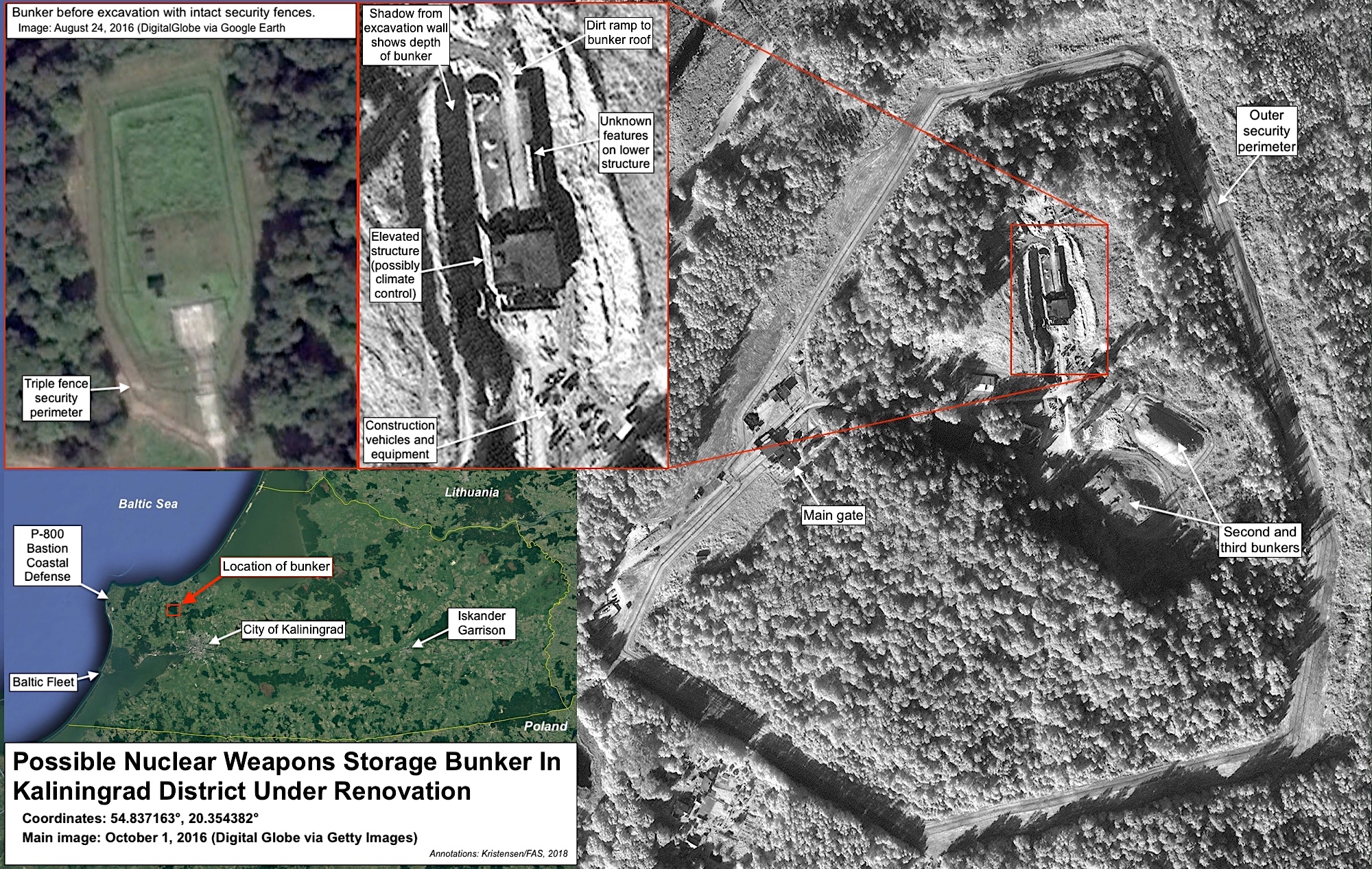
A buried nuclear weapons storage bunker in the Kaliningrad district has been under major renovation since mid-2016. Click on image to see full size.
By Hans M. Kristensen
During the past two years, the Russian military has carried out a major renovation of what appears to be an active nuclear weapons storage site in the Kaliningrad region, about 50 kilometers from the Polish border.
A Digital Globe satellite image purchased via Getty Images, and several other satellite images viewable on TerraServer, show one of three underground bunkers near Kulikovo being excavated in 2016, apparently renovated, and getting covered up again in 2018 presumably to return operational status soon.
The site was previously upgraded between 2002 and 2010 when the outer security perimeter was cleared. I described this development in my report on U.S. and Russian non-strategic nuclear weapons from 2012.
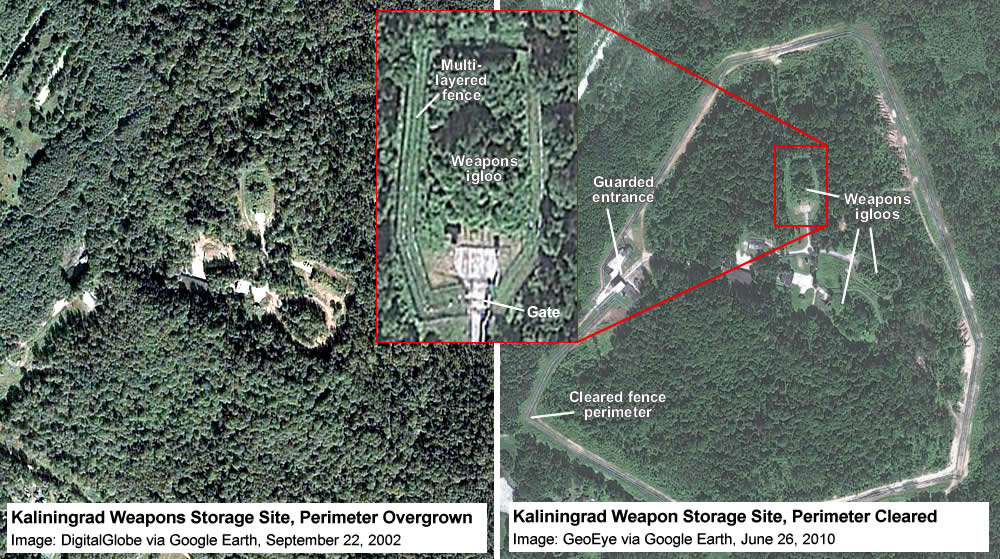
Between 2002 and 2010, the security perimeter around the Kulikovo nuclear weapons storage site were cleared and upgraded. Click on image to view full size.
The latest upgrade obviously raises questions about what the operational status of the site is. Does it now, has it in the past, or will it in the future store nuclear warheads for Russian dual-capable non-strategic weapon systems deployed in the region? If so, does this signal a new development in Russian nuclear weapons strategy in Kaliningrad, or is it a routine upgrade of an aging facility for an existing capability? The satellite images do not provide conclusive answers to these questions. The Russian government has on numerous occasions stated that all its non-strategic nuclear warheads are kept in “central” storage, a formulation normally thought to imply larger storage sites further inside Russia. So the Kulikovo site could potentially function as a forward storage site that would be supplied with warheads from central storage sites in a crisis.
The features of the site suggest it could potentially serve Russian Air Force or Navy dual-capable forces. But it could also be a joint site, potentially servicing nuclear warheads for both Air Force, Navy, Army, air-defense, and costal defense forces in the region. It is to my knowledge the only nuclear weapons storage site in the Kaliningrad region. Despite media headlines, the presence of nuclear-capable forces in that area is not new; Russia deployed dual-capable forces in Kaliningrad during the Cold War and has continued to do so after. But nearly all of those weapon systems have recently been, or are in the process of being modernized. The Kulikovo site site is located:
So there are many potential clients for the Kulikovo nuclear weapons storage site. Similar upgrades have been made to other Russian nuclear weapons storage sites over the base decade, including for the Navy’s nuclear submarine base on the Kamchatka peninsula. There are also ongoing upgrades to other weapons storage sites in the Kaliningrad region, but they do not appear to be nuclear.
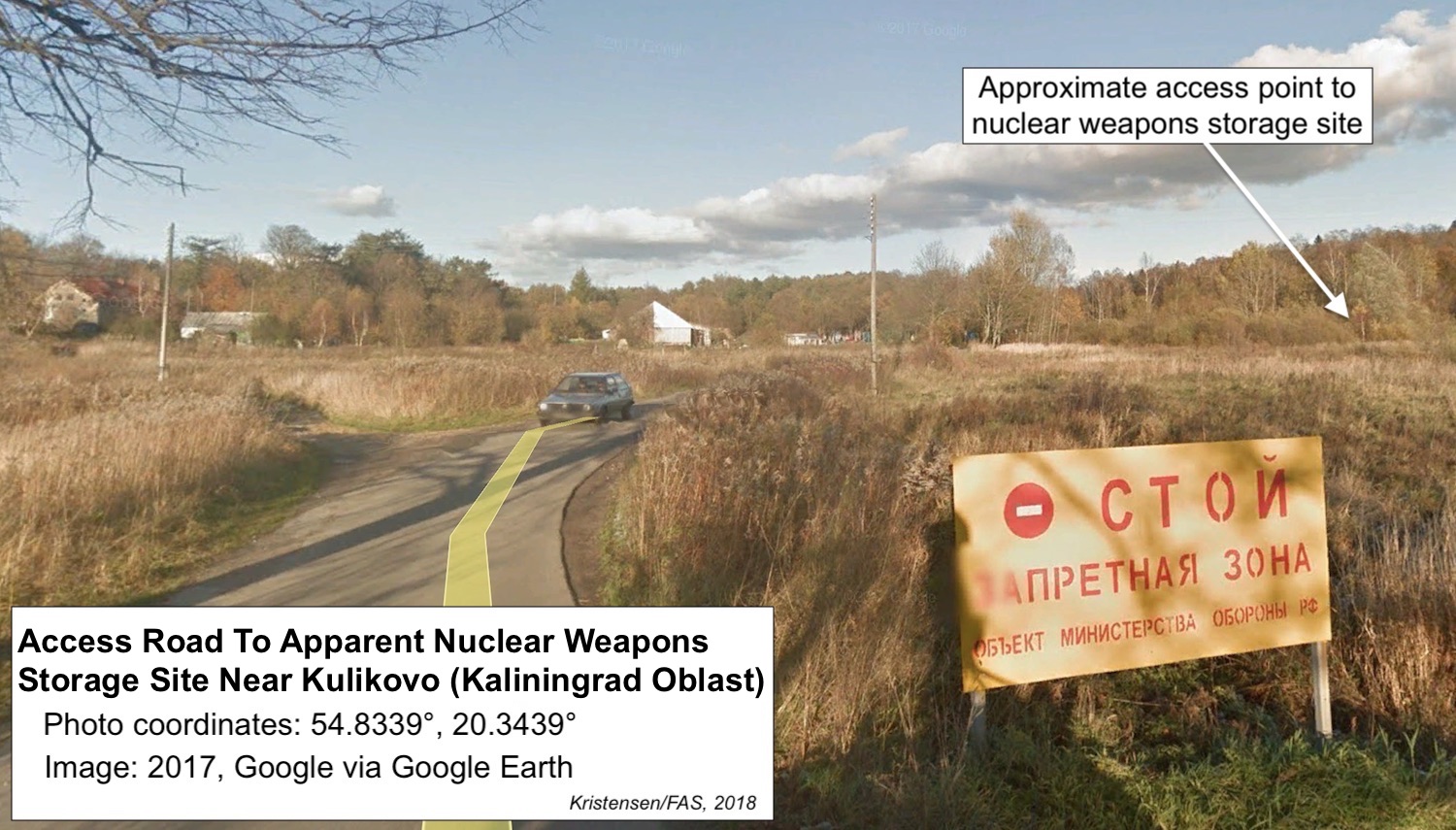
A Google street-view image from 2017 shows a military stop sign at the approach to the suspected nuclear weapons storage site north of Kaliningrad. Click image to view full size.
The issue of Russian non-strategic nuclear weapons has recently achieved new attention because of the Trump administration’s Nuclear Posture Review, which accused Russia of increasing the number and types of its non-strategic nuclear weapons. The Review stated Russia has “up to 2,000” non-strategic nuclear weapons, indirectly confirming FAS’ estimate.
NATO has for several years urged Russia to move its nuclear weapons further back from NATO borders. With Russia’s modernization of its conventional forces, there should be even less, not more, justification for upgrading nuclear facilities in Kaliningrad.
Additional Resources:
This publication was made possible by generous grants from the John D. and Catherine T. MacArthur Foundation, Ploughshares Fund, New Land Foundation, and the Carnegie Corporation of New York. The statements made and views expressed are solely the responsibility of the author.
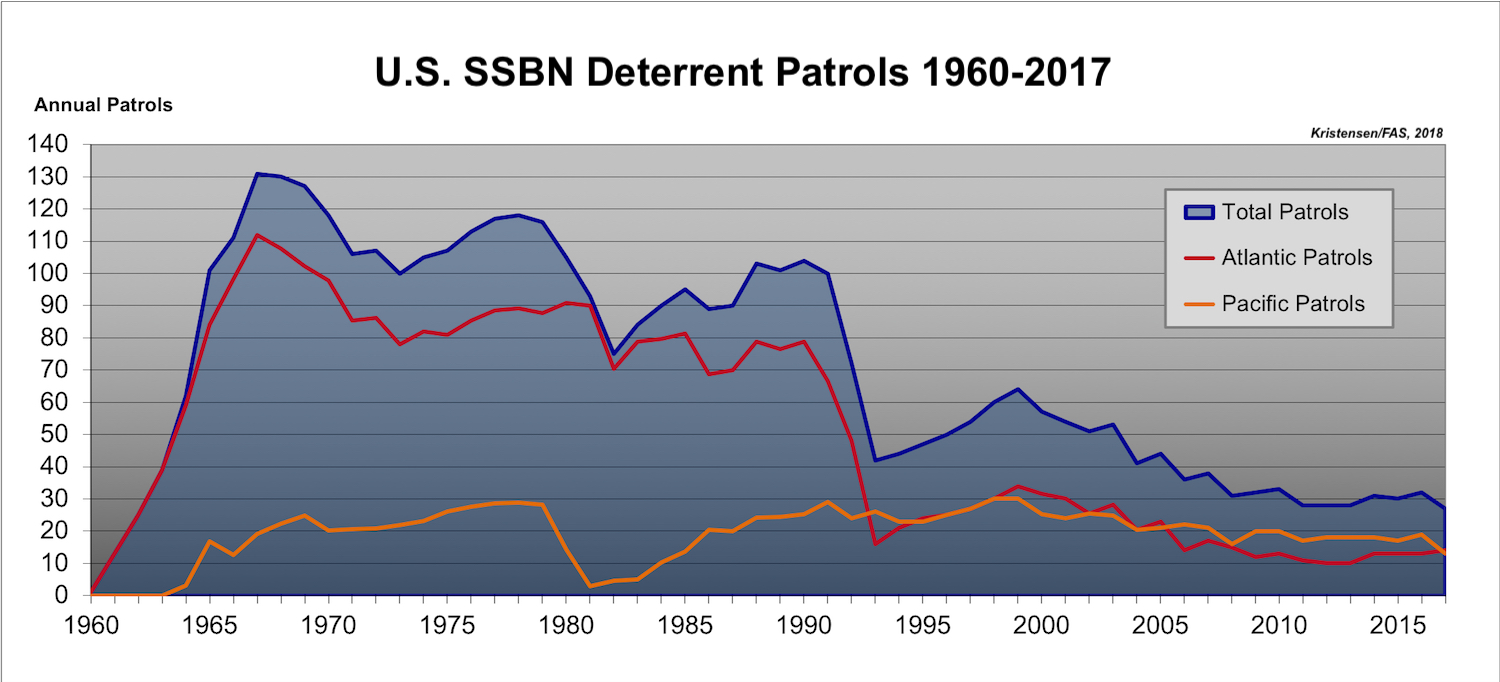
The U.S. SSBN fleet conducted 27 nuclear deterrent patrols in 2017, but with a mysterious reduction in the Pacific. Click graph to view full size.
By Hans M. Kristensen
Despite their age, U.S. nuclear ballistic missile submarines (SSBNs) continue to carry out strategic deterrent patrols at a steady rate of around 30 patrols per year, according to data obtained from the U.S. Navy under the Freedom of Information Act (FOIA) by the Federation of American Scientists’ Nuclear Information Project.
Yet the data shows the U.S. SSBN fleet conducted a total of 27 patrols in 2017 (five less than in 2016), the lowest number of patrols in as single year since the early-1960s when SSBN deterrent patrols began. Even so, the fluctuations are small, modern SSBNs patrol longer than 1960s SSBNs, and the overall patrol number has remained relatively steady for the past decade.
Nonetheless, the new data reveals a mysterious reduction of deterrent patrols in the Pacific in 2017: a nearly one-third drop from the 2016 level of 19 patrols to only 13 in 2017. The drop in Pacific patrols in 2017 happened despite completion of a second Explosive Handling Wharf at the Kitsap-Bangor Submarine Base that same year, which is intended to allow for additional maintenance needed as the submarines get older.
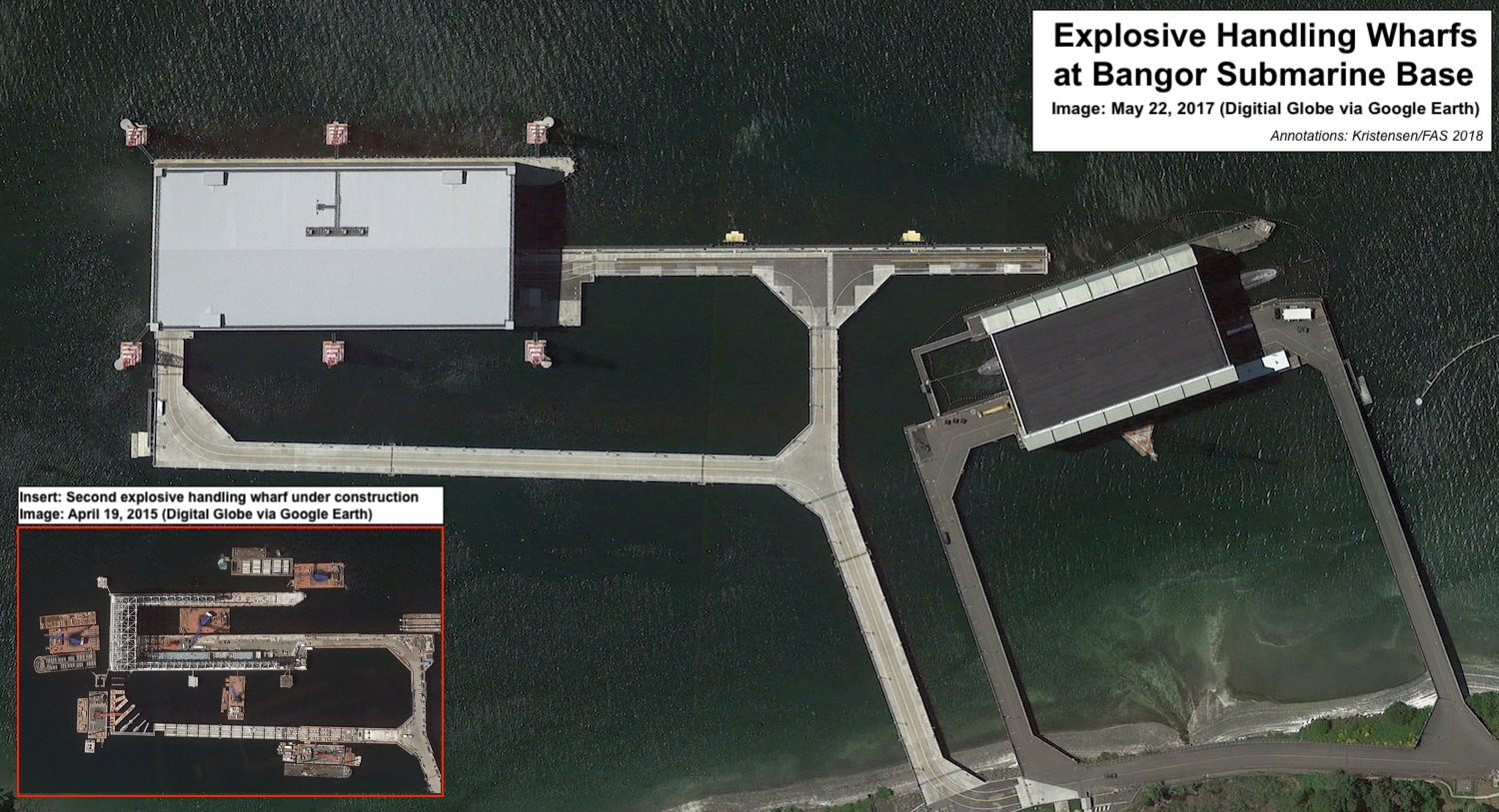
The drop in Pacific SSBN patrols happened despite completion of a second explosive handling wharf at Bangor. Click on image to view full size.
It is unknown what has caused the Pacific reduction. The size of the SSBN fleet at Kitsap-Bangor Submarine Base hasn’t changed, the Navy and U.S. Strategic Command haven’t announced a change in strategy, and there has been no public reports about serious technical problems that could have forced the reduction.
In any case, the SSBN fleet appears have picked up some patrol slack in early-2018. In mid-March this year, the Navy told Congress that SSBNs “conducted 33 strategic deterrent patrols…over the past year,” or five more than the 27 patrols the FOIA release says were conducted through 2017.
Coinciding with the reduction in Pacific patrols, the smaller Atlantic SSBN fleet (6 boats versus 8 in the Pacific) increased its patrols slightly in 2017 (from 13 to 14). As a result, the Atlantic SSBNs in 2017 conducted more deterrent patrols than the Pacific SSBN fleet for the first time since 2005 (14 patrol versus 13 patrols, respectively) when the majority of the SSBN force was shifted to operations in the Pacific.
Altogether, between 1960 and 2017, the US SSBN fleet conducted a total of 4,083 deterrent patrols, which adds up to an average of just over three patrols per submarine per year.
The Navy occasionally announces in public when SSBNs complete deterrent patrols, and less frequently when they begin a patrol. But it far from announces all of them. During the past decade, for example, only about one-third of the annual patrols were announced on average.
The duration of SSBN patrols can vary considerably. The Ohio-class SSBN is designed for 70-day patrols but individual patrols can be cut short by technical difficulties, in which case another submarine will have to take over the assignment. Similarly, sometimes a submarine approaching the end of its scheduled patrol will be forced stay out longer cause the submarine that was supposed to replace it delayed by technical problems. In 2014, for example, the USS Pennsylvania (SSBN-735) stayed out for 140 days – more than four-and-a-half months or twice its normal patrol duration – because of maintenance problems with its replacement submarine. The Navy said it was the longest patrol ever conducted by an Ohio-class SSBN. Again, toward the end of 2017, the USS Pennsylvania stayed on patrol for 116 days.

The USS Pennsylvania (SSBN-735) arrives at Kitsap-Bangor Submarine Base on June 14, 2014, after a 140-day deterrent patrol – the longest ever for an Ohio-class SSBN. Click image to view full size.
The USS Pennsylvania was commissioned in September 1989 – 29 years ago – and completed a mid-life complex reactor refueling overhaul in 2012. The boat is scheduled to be retired in 2031 at age 42, the year the first new Columbia-class (SSBN-826) will sail on its first deterrent patrol.

The 14 Ohio-class SSBNs will start retiring in 2027 and be replaced by 12 Columbia-class SSBNs from 2031. During much of the 2020s, the Navy will have more deployable SSBNs than it needs. Click graph to view full size.
Of the Navy’s 14 Ohio-class SSBNs, 12 are considered deployable (the 13th and 14th boats are in refueling overhaul). Of those, an average of 8-9 are normally at sea, of which 4-5 are thought to be on “hard alert” within range and position of their priority target strike package. The deployed SSBN force normally carries just over 200 SLBMs with around 900 warheads. Another 1,000 SLBM warheads are in storage for potential upload if necessary.
The last two SSBN reactor refueling overhauls will be completed in 2020-2021, after which the Navy will be operating 14 deployable SSBNs, or two more than it needs for deterrent operations. At that point, the two oldest SSBNs – USS Henry M. Jackson (SSBN-730) and USS Alabama (SSBN-731) – can probably be retired.
This publication was made possible by generous grants from the John D. and Catherine T. MacArthur Foundation, Ploughshares Fund, and the Carnegie Corporation of New York. The statements made and views expressed are solely the responsibility of the author.
The US Air Force has published new guidance for training military and civilian personnel to maintain nuclear weapons as a career specialty.
See Nuclear Weapons Career Field Education and Training Plan, Department of the Air Force, April 1, 2018.
An Air Force nuclear weapons specialist “inspects, maintains, stores, handles, modifies, repairs, and accounts for nuclear weapons, weapon components, associated equipment, and specialized/general test and handling equipment.” He or she also “installs and removes nuclear warheads, bombs, missiles, and reentry vehicles.”
A successful Air Force career path in the nuclear weapons specialty proceeds from apprentice to journeyman to craftsman to superintendent.
“This plan will enable training today’s workforce for tomorrow’s jobs,” the document states, confidently assuming a future that resembles the present.
Meanwhile, however, the Air Force will also “support the negotiation of, implementation of, and compliance with, international arms control and nonproliferation agreements contemplated or entered into by the United States Government,” according to a newly updated directive.
See Air Force Policy Directive 16-6, International Arms Control and Nonproliferation Agreements and the DoD Foreign Clearance Program, 27 March 2018.
The number of nuclear weapons in the U.S. nuclear stockpile dropped to 3,822 as of September 30, 2017, down from 4,018 a year earlier. (Retired weapons awaiting dismantlement are not included in the totals.)The totals do not include weapons that are retired and awaiting dismantlement.)
Meanwhile, 354 nuclear weapons were dismantled in 2017, up from 258 the year before.
These figures were declassified in response to a request from the Federation of American Scientists and were made public yesterday.
The declassification of the current size of the US nuclear arsenal was a breakthrough in national security transparency that was accomplished for the first time by the Obama Administration in 2010.
It was uncertain until now whether or when the Trump Administration would follow suit.
Because the stockpile information qualifies as Formerly Restricted Data under the Atomic Energy Act, its declassification does not occur spontaneously or on a defined schedule. Disclosure requires coordination and approval by both the Department of Energy and the Department of Defense, and it often needs to be prompted by some external factor.
Last October, the Federation of American Scientists petitioned for declassification of the stockpile numbers, and the request was ultimately approved.
“Your request was the original driver for the declassification,” said Dr. Andrew Weston-Dawkes, the director of the DOE Office of Classification. “We regret the long time to complete the process but in the end the process does work.”
Earlier this week, FAS requested declassification of the current inventory of Highly Enriched Uranium, which has not been updated since 2013.
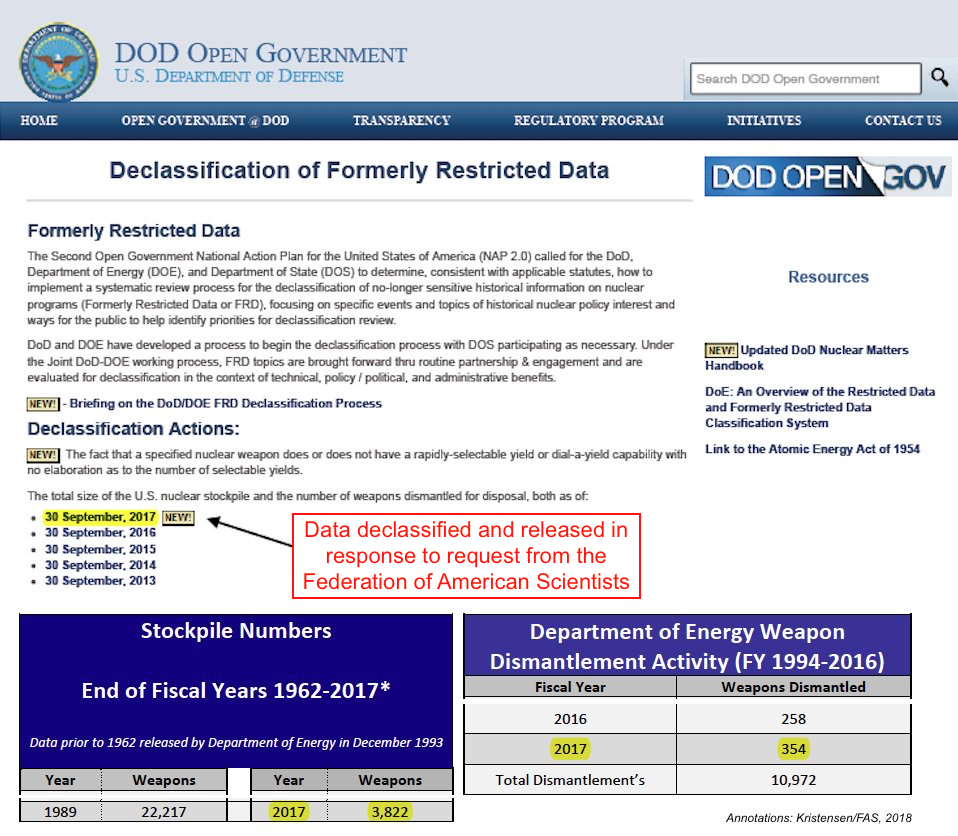
Click on image to view full size. Full document here.
By Hans M. Kristensen
The US nuclear weapons stockpile dropped to 3,822 warheads by September 2017 – down nearly 200 warheads from the last year of the Obama administration, according to new information released by the Department of Defense in response to a request from the Federation of American Scientists (see here for full document).
Since September 2017, the number has likely declined a little further to about 3,800 warheads as of March 2018. This is the lowest number of stockpiled warheads since 1957 (see graph), although the nuclear weapons and the conventional capabilities that make up today’s arsenal are vastly more capable than back then.
The new data also shows that the United States dismantled 354 warheads during the period October 2016 to September 2017 – the highest number of warheads dismantled in a single year since 2009. Since 1994, the United States has dismantled nearly 11,000 nuclear warheads.
The continued reductions are not the result of new arms control agreements or a change in defense planning, but reflects a longer trend of the Pentagon working to reduce excess numbers of warheads while upgrading the remaining weapons. This trend is as old as the Post Cold war era.
The majority of the warheads retired during the Trump administration’s first year probably included W76-0 warheads no longer needed as feedstock for the Navy’s W76-1 life-extension program.
The reduction has happened despite tensions with Russia, bombastic nuclear statements by President Donald Trump, and Nuclear Posture Review assertions about return of Great Power competition and need for new nuclear weapons.
The apparent disconnect between rhetoric and the stockpile trend illustrates that nuclear deterrence and national security are less about the size of the arsenal than what it, and the overall defense posture, can do and how it is postured.
Although defense hawks home and abroad will likely seize upon the reduction and argue that it undermines deterrence and reassurance, the reality is that it does not; the remaining arsenal is more than sufficient to meet the requirements for national security and international obligations. On the contrary, it is a reminder that there still is considerable excess capacity in the current nuclear arsenal beyond what is needed.
President Trump recently said he expected to meet Russian President Vladimir Putin “in the not-too-distant future to discuss the arms race,” which Trump added “is getting out of control…” He is right. In such discussions he should urge Russia to follow the U.S. example and also disclose the size of its nuclear warhead stockpile, agree to extend the New START treaty for five years, work out a roadmap to resolve INF Treaty compliance issues, and develop new agreements to regulate nuclear and advanced conventional forces.
There is much work to be done.
Additional information:
Declassified stockpile numbers.
Recent FAS Nuclear Notebook on US nuclear forces (written before the new stockpile information became available).
For an overview of all nuclear-armed states, see our Status of World Nuclear Forces.
This publication was made possible by a grant from the Carnegie Corporation of New York, the John D. and Catherine T. MacArthur Foundation, the New Land Foundation, and the Ploughshares Fund. The statements made and views expressed are solely the responsibility of the author.
The Congressional Research Service recently updated its report on US nuclear weapons and programs. See U.S. Strategic Nuclear Forces: Background, Developments, and Issues by Amy F. Woolf, March 6, 2018.
That is also the subject of a new survey prepared by Hans M. Kristensen and Robert S. Norris of the Federation of American Scientists. See United States nuclear forces, 2018, Bulletin of the Atomic Scientists, March 5, 2018.
Other new and updated reports from the Congressional Research Service include the following.
Joint Resolution Seeks to End U.S. Support for Saudi-led Coalition Military Operations in Yemen, CRS Insight, March 5, 2018
Iraq: In Brief, March 5, 2018
Tensions in the Eastern Mediterranean Focus on the Politics of Energy, CRS Insight, March 1, 2018
Qatar: Governance, Security, and U.S. Policy, updated March 1, 2018
Millennium Challenge Corporation, updated March 7, 2018
Material Support for Terrorism Is Not Always an “Act of International Terrorism,” Second Circuit Holds, CRS Legal Sidebar, March 5, 2018
So, Now Can Menachem Zivotofsky Get His Passport Reissued to Say “Israel”?, CRS Legal Sidebar, March 1, 2018
Responding to the Opioid Epidemic: Legal Developments and FDA’s Role, CRS Legal Sidebar, March 6, 2018
Banking Policy Issues in the 115th Congress, updated March 7, 2018
How Hard Should It Be To Bring a Class Action?, CRS Legal Sidebar, March 7, 2018
The Trump Administration requested $11.02 billion for maintenance and refurbishment of nuclear weapons in the coming year. This represents a 19% increase over the amount appropriated in FY2017.
Recent and proposed nuclear weapons-related spending is detailed by Amy F. Woolf of the Congressional Research Service in Energy and Water Development Appropriations: Nuclear Weapons Activities, February 27, 2018.
Another new CRS report discusses blockchain, the technology that underlies cryptocurrencies such as Bitcoin. Blockchain provides a way to securely record transactions of various types. “Despite public intrigue and excitement around the technology, questions still surround what it is, what it does, how it can be used, and its tradeoffs.”
“This report explains the technologies which underpin blockchain, how blockchain works, potential applications for blockchain, concerns with it, and potential considerations for Congress.” See Blockchain: Background and Policy Issues, February 28, 2018.
Other recent reports from the Congressional Research Service include the following.
Defense Spending Under an Interim Continuing Resolution: In Brief, updated February 23, 2018
Armed Conflict in Syria: Overview and U.S. Response, updated February 27, 2018
U.S. Foreign Aid to Israel, updated February 26, 2018
Federal Civil Aviation Programs: In Brief, updated February 27, 2018
Health Care for Dependents and Survivors of Veterans, updated February 26, 2018
Joint Light Tactical Vehicle (JLTV): Background and Issues for Congress, updated February 27, 2018
The European Union: Questions and Answers, updated February 23, 2018
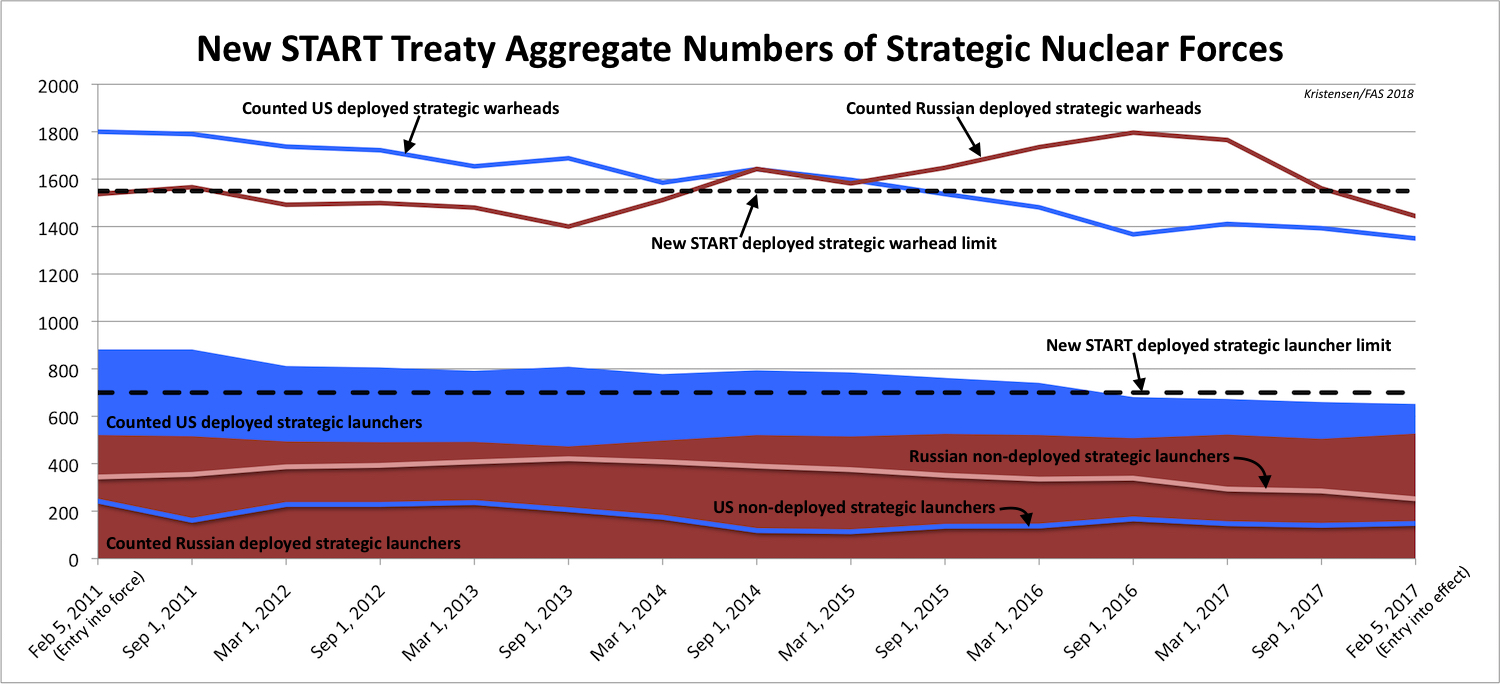
Russia and the United States are currently in compliance with the treaty limits of the New START treaty. This table summarizes the evolution of the three weapons categories reported between 2011 and 2018. (Click on graph to view full size.)
By Hans M. Kristensen
[Note: On February 22nd, the US State Department published updated numbers instead of relying on September 2017 numbers. This blog and tables have been updated accordingly.]
Seven years after the New START treaty between Russia and the United States entered into force in 2011, the treaty entered into effect on February 5. The two countries declared they have met the limits for strategic nuclear forces.
At a time when relations between the two countries are at a post-Cold War low and defense hawks in both countries are screaming for new nuclear weapons and declaring arms control dead, the achievement couldn’t be more timely or important.
Achievements by the Numbers
The declarations show that Russia and the United States currently deploy a combined total of 2,794 warheads on 1,179 deployed strategic launchers. An additional 400 non-deployed launchers are empty, in overhaul, or awaiting destruction.
Compare that with the same categories in 2011: 3,337 warheads on 1,403 deployed strategic launchers with an additional 586 non-deployed launchers.
In other words, since 2011, the two countries have reduced their combined strategic forces by: 543 deployed strategic warheads, 224 deployed strategic launchers, and 186 non-deployed strategic launchers. These are modest reductions of about 16 percent over seven years for deployed forces (see chart below).
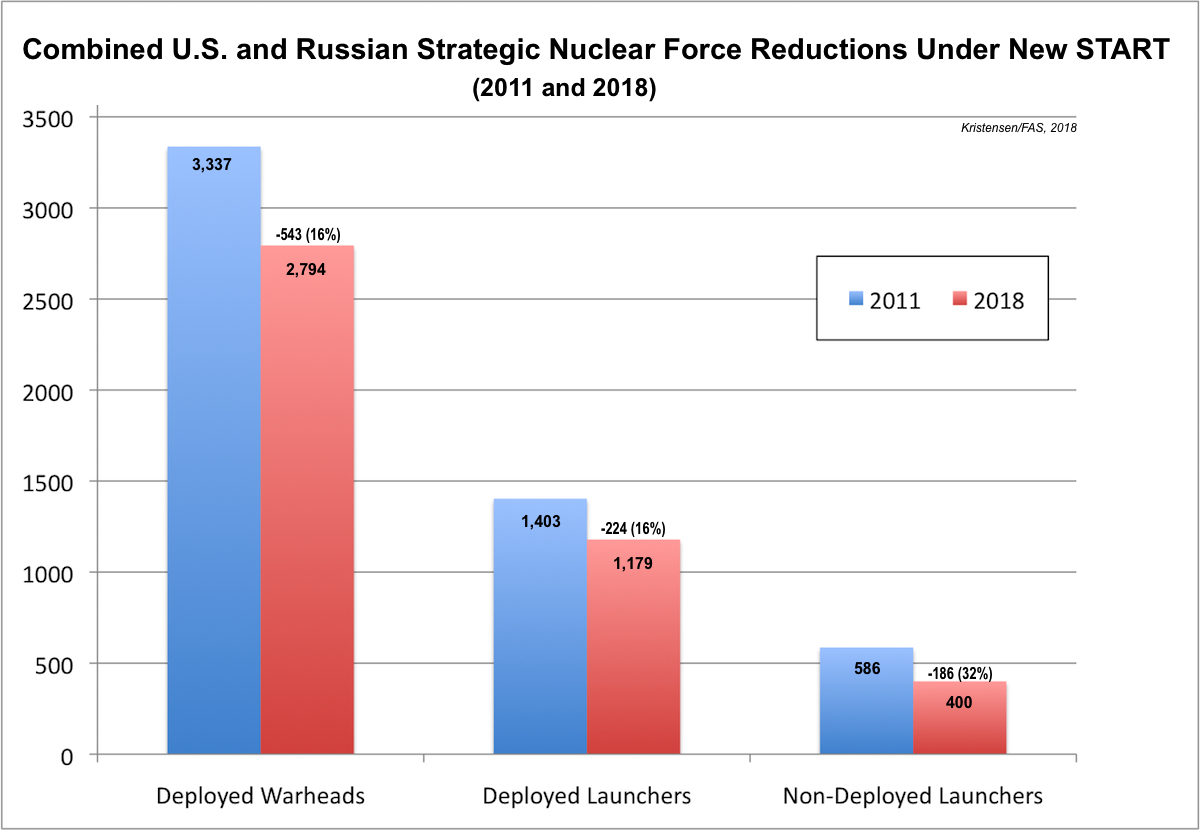
The New START data shows the world’s two largest nuclear powers have reduced their deployed strategic force by about 15 percent over the past seven years. (Click on graph to view full size.)
The Russian statement reports 1,444 warheads on 527 deployed strategic launchers with another 392 non-deployed launchers.
That means Russia since 2011 has reduced its deployed strategic warheads by 93, or only 6 percent. The number of deployed launchers has increased a little, by 6, while non-deployed launchers have declined by 80, or 24 percent (see chart below).
The Russian numbers hide an important new development: In order to meet the New START treaty limit, the warhead loading on some Russian strategic missiles has been reduced. The details of the download are not apparent from the limited data published by Russia. I am currently working on developing the estimate for how the download is distributed across the Russian strategic forces. The analysis will be published in a subsequent blog, as well in our next FAS Nuclear Notebook and in the 2018 SIPRI Yearbook.
The US statement lists 1,350 warheads on 652 deployed strategic launchers, and 148 non-deployed launchers.
That means the United States since 2011 has reduced its deployed strategic warheads by 450, or 25 percent. The number of deployed launchers has been reduced by 230, or 26 percent, while the number of non-deployed launchers had declined by 94, or 39 percent (see chart below).
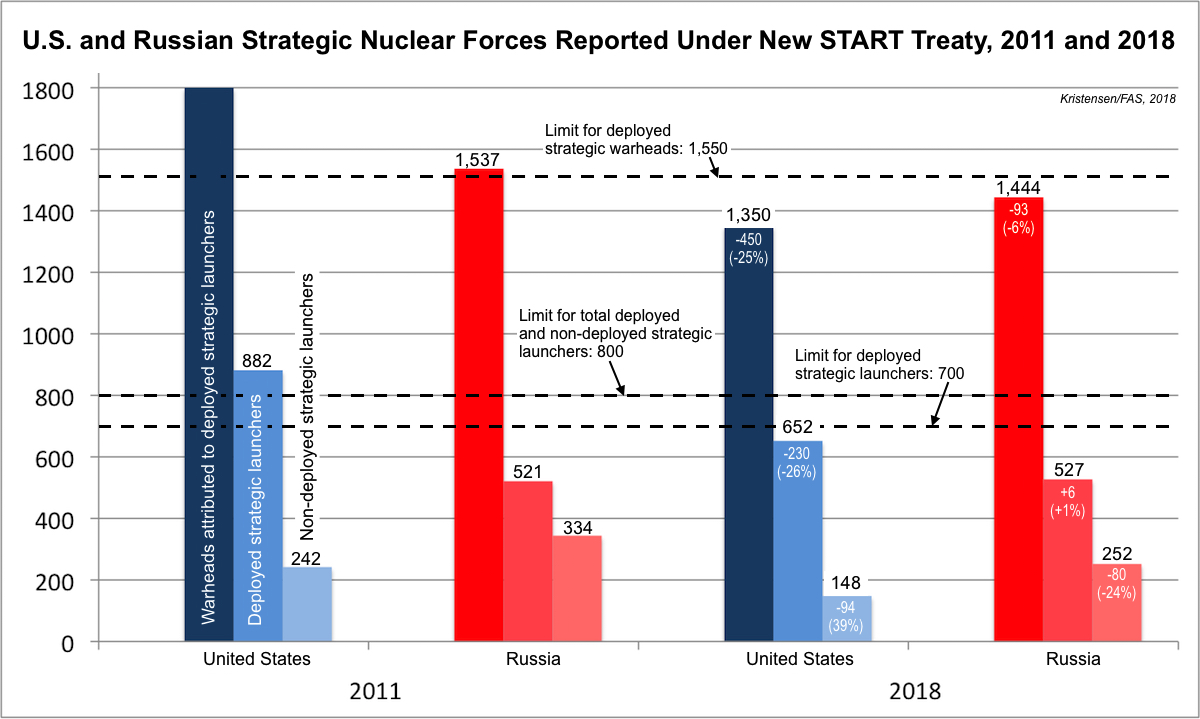
US and Russian strategic force structures differ significantly. As a result, the reductions under New START have affected the two countries differently. Russia has significantly fewer launchers so rely on great warhead-loading to maintain rough overall parity. (Click on chart to view full size.)
In Context
The reason for the different reductions is, of course, that the United States in 2011 had significantly more warheads and launchers deployed than Russia. During the New START negotiations, the US military insisted on a higher launcher limit than proposed by Russia. So while Russia by the latest count has 94 deployed warheads more than the United States, the United States enjoys a sizable advantage of 125 deployed strategic launchers more than Russia. Those extra launchers have a significant warhead upload capacity, a potential treaty breakout capability that Russian officials often complain about.
So despite the importance of the New START treaty and its achievements, not least its important verification regime, the declared numbers are a reminder of how far the two nuclear superpowers still have to go to reduce their unnecessarily large nuclear forces. Ironically, because the US military insisted on a higher launcher limit, Russia could – if it decided to do so, although that seems unlikely – build up its strategic launchers to reduce the US advantage, and still be in compliance with the treaty limits. The United States, in contrast, is at full capacity.
But the apparent download of warheads on Russia’s strategic missiles demonstrates an important effect of New START: It actually keeps a lid on the strategic force levels.
Still, not to forget: The deployed strategic warhead numbers counted under New START represent only a portion of the total number of warheads the two countries have in the arsenals. We estimate that the deployed strategic warheads declared by the two countries represent on about one-third of the total number of warheads in their nuclear stockpiles (see here for details).
This all points to the importance of the two countries agreeing to extend the New START treaty for an additional five years before it expires in 2021. Neither can afford to abandon the only strategic limitations treaty and its verification regime. Failing this most basic responsibility would, especially in the current political climate, remove any caps on strategic nuclear forces and potentially open the door to a new nuclear arms race. The warning signs are all there: East and West are in an official adversarial relationship, increasing military posturing, modernizing and adding nuclear weapons to their arsenals, and adjusting their nuclear policies for a return to Great Power competition.
The symbolic importance of New START could not be greater!
This publication was made possible by a grant from the Carnegie Corporation of New York, the John D. and Catherine T. MacArthur Foundation, the New Land Foundation, and the Ploughshares Fund. The statements made and views expressed are solely the responsibility of the author.
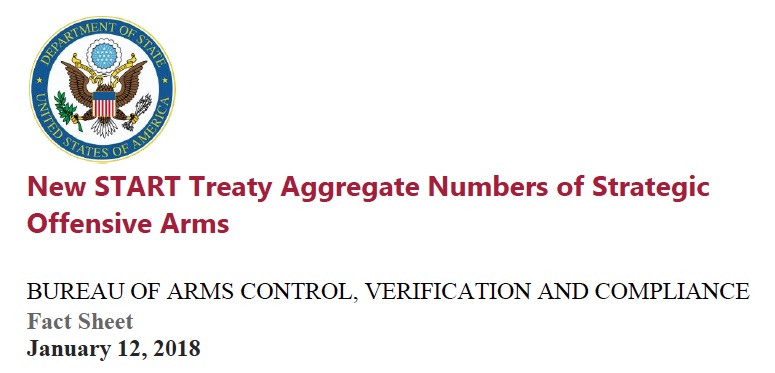
By Hans M. Kristensen
The full unclassified New START treaty data set released by State Department yesterday shows that the US reduction of its nuclear forces to meet the treaty limit had been completed by September 1, 2017, more than four months early before the deadline next month on February 5, 2018.
The data set reveals details about how the final reduction was achieved (see below).
Unfortunately, no official detailed data is released about the Russian force adjustments under New START. Our previous analysis of the overall September 1, 2017 New START data is available here.
Submarines
During that six-month period last year, 20 ballistic missile submarine launch tubes were deactivated, corresponding to four tubes on five Ohio-class submarines. Two of those submarines were in drydock for refueling and not part of the operational force.
In total, the United States has deactivated 56 strategic missile submarine launch tubes since the New START treaty went into effect in 2011, although the first reduction didn’t begin until after September 2016 – more than five years into the treaty.
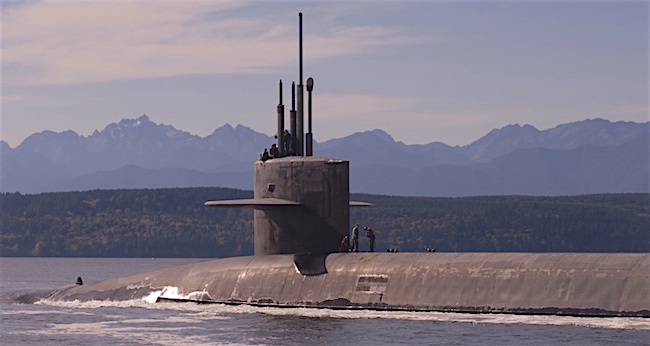
The USS Louisiana (SSBN-743) returns to Kitsap Submarine Base in Washington on October 15, 2017 after a deterrent patrol in the Pacific Ocean. The submarine carried 20 Trident II missiles with an estimated 90 nuclear warheads.
Of the 280 submarine launch tubes, only 212 were counted as deployed with as many Trident II missiles loaded. The treaty counts a missile as deployed if it is in a launch tube regardless of whether the submarine is deployed at sea. The United States has declared that it will not deploy more than 240 missiles at any time. Assuming each deployed submarine carries a full missile load, the 212 deployed missiles correspond to 10 submarines fully loaded with a total of 200 missiles. The remaining 12 deployed missiles were onboard one or two submarines loading or offloading missiles at the time the count was made.
The data shows that the 212 deployed missiles carried a total of 945 warheads, or an average of 4 to 5 warheads per missile, corresponding to 70 percent of the 1,344 deployed warheads as of September 1, 2017 (the New START count was 1,393 deployed warheads, but 49 bombers counted as 49 weapons don’t actually carry warheads, leaving 1,344 actual warheads deployed). If fully loaded, the 240 deployable SLBMs could carry nearly 2,000 warheads.
The Navy has begun replacing the original Trident II D5 missile with an upgraded version known as Trident II D5LE (LE for life-extension). The upgraded version carries the new Mk6 guidance system and the enhanced W76-1/Mk4A warhead (or the high-yield W88-0/Mk5). In the near future, according to the Trump administration’s Nuclear Posture Review (NPR), some of the missiles would be equipped with a low-yield version of the W76-1.
The Navy is developing a new fleet of 12 Columbia-class missile submarines to begin replacing the Ohio-class SSBNs in the late-2020s. The Trump NPR states that “at least” 12 will be built. Each Columbia-class SSBN, the first of which will deploy on deterrent patrol in 2031, will have 16 missile tubes for a total of 192, a reduction of one-third from the current number of SSBN tubes. Ten deployable boats will be able to carry 160 Trident II D5LE missiles with a maximum capacity of 1,280 warheads; normally they will likely carry about the same number of warheads as the current force, with an average of about 5 to 6 warheads per missile.
ICBMs
The New START data shows the United States now has just under 400 Minuteman III ICBMs in silos, down from 405 in March 2017. Normally the Air Force strides to have 400 deployed but one missile was undergoing maintenance.
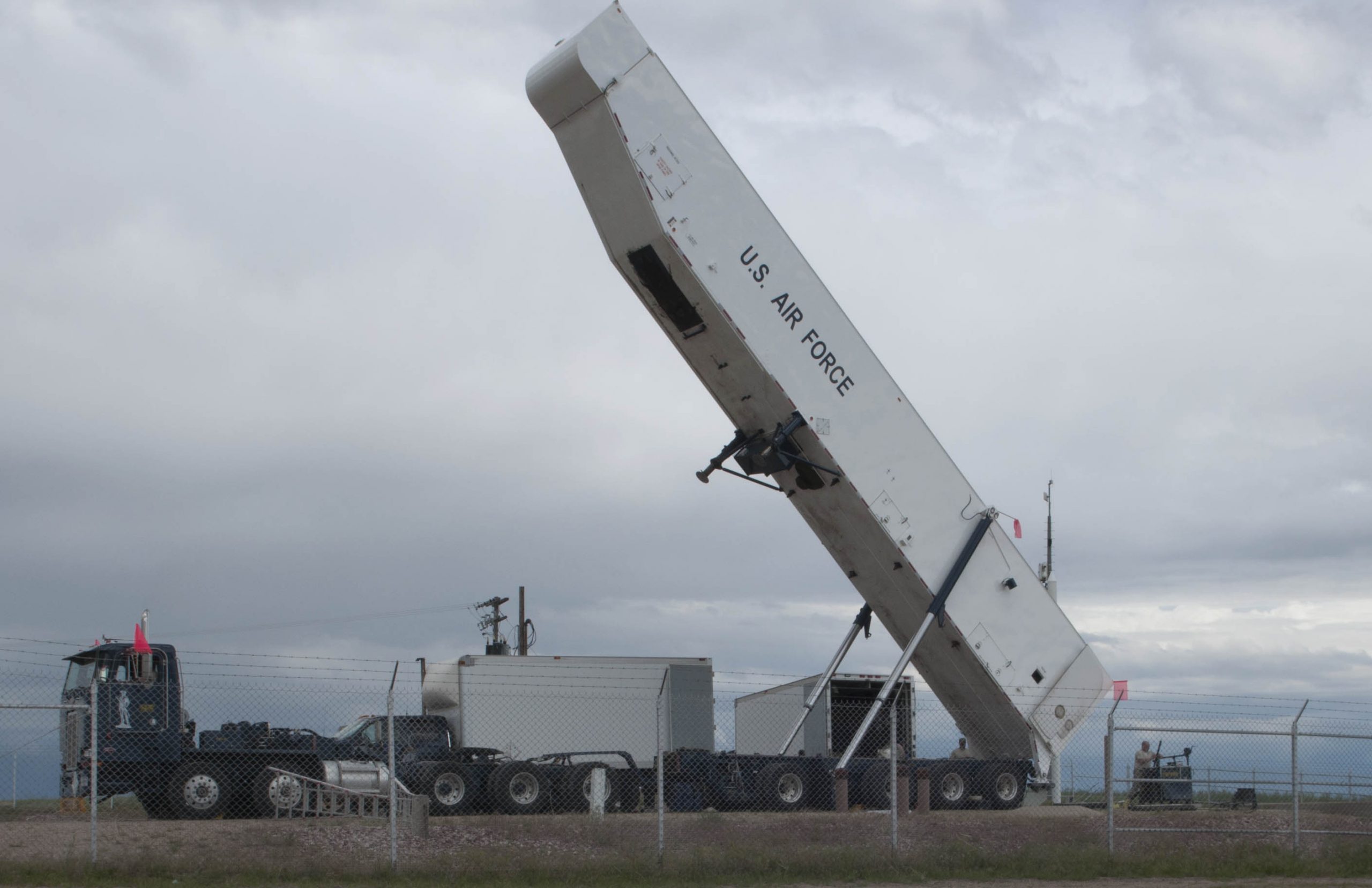
A Minuteman III ICBM is removed from its silo at F.E. Warren AFB on June 2, 2017, the last to be offloaded to bring the United States into compliance with the New START treaty limits.
Although the number of deployed ICBMs had declined from 450 to 400, the total numbers of missiles and silos have not. The data shows the Air Force has the same number of missiles and silos as in March 2017 because 50 empty silos are “kept warm” and ready to load 50 non-deployed missiles if necessary. Reduction of deployed ICBMs started in 2016, five years after the New START was signed. And the actual ICBM force is the same size as when the treaty was signed.
The 399 deployed ICBMs carried 399 W78/Mk12A or W87/Mk21 warheads. Although normally loaded with only one warhead each, the Trump NPR confirms that “a portion of the ICBM force can be uploaded” if necessary. We estimate the ICBM force has the capacity to carry a maximum of 800 warheads.
An ICBM replacement program is underway to build a new ICBM (programmatically called Ground Based Strategic Deterrent) to begin replacing the Minuteman III from 2029. The new ICBM will have enhanced penetration and warhead fuzing capabilities.
Heavy Bombers
The New START data shows the US Air Force has completed the denuclearization of excess nuclear bombers to 66 aircraft. This includes 20 B-2A stealth bombers for gravity bombs and 46 B-52H bombers for cruise missiles. Only 49 of the 66 bombers were counted as deployed as of September 1, 2017. Another 41 B-52Hs have been converted to non-nuclear armament such as the conventional long-range JASSM-ER cruise missile.
The New START treaty counts each of the 66 bombers as one weapon even though each B-2A can carry up to 16 bombs and each B-52H can carry up to 20 cruise missiles. We estimate there are nearly 1,000 bombs and cruise missiles available for the bombers, of which about 300 are deployed at two of the three bomber bases.

The first B-52H bomber was denuclearized under New START in September 2015. Denuclearization of excess nuclear bombers was completed in early 2017.
The bomber force was the first leg of the Triad to begin reductions under New START, starting with denuclearization of the (non-operational) B-52Gs and later excess B-52Hs. The first B-52H war denuclearized in September 2015 and the last of 41 in early 2017. Despite the denuclearization of excess aircraft, however, the actual number of bombers assigned nuclear strike missions under the strategic war plans is about the same today as in 2011.
A new heavy bomber known as the B-21 Raider is under development and planned to begin replacing nuclear and conventional bombers in the mid-2020s. The B-21 will be capable of carrying both the new B61-12 guided nuclear bomb and the new LRSO nuclear cruise missile. The Air Force wants at least 100 B-21s but can only make 66 nuclear-capable unless it plans to exceed the size of the current nuclear bomber force.
Looking Ahead
With the completion of the force reductions under New START in preparation for the treaty entering into effect on February 5, 2018, the attention now shifts to what Russia and the United States will do to extend the treaty or replace it with a follow-up treaty. With its on-site inspections and ceilings on deployed and non-deployed strategic forces, extending New START treaty for another five years ought to be a no-brainer for the two countries; anything else would increase risks to strategic stability and international security. If the treaty is allowed to expire in 2021, there will be no – none! – limits on the number of strategic nuclear forces. Unfortunately, right now neither side appears to be doing anything except to blame the other side for creating problems. It is time for Russia and the United States to get out of the sandbox and behave like responsible states by agreeing to extend the New START treaty. February 5 – when the treaty enters into effect just 23 days from now – would be a great occasion for the two countries to announce their decision to extend the treaty.
This publication was made possible by a grant from the Carnegie Corporation of New York, the John D. and Catherine T. MacArthur Foundation, the New Land Foundation, and the Ploughshares Fund. The statements made and views expressed are solely the responsibility of the author.
Updated: 2/6/2018, 15:32
The Nuclear Posture Review (NPR) is the Pentagon’s primary statement of nuclear policy, produced by the last three presidents in their first years in office.
The Trump NPR perceives a rapidly deteriorating threat environment in which potential nuclear-armed adversaries are increasing their reliance on nuclear weapons and follows suit. The review reverses decades of bipartisan policy and orders what would be the first new nuclear weapons since the end of the Cold War. Furthermore, the document expands the use of circumstances in which the United States would consider employing nuclear weapons to include “non-nuclear strategic attacks.”
You can view the first version of the document here.
You can also view the leaked draft document here.
The 2018 NPR says US nuclear forces “contribute uniquely to the deterrence of both nuclear and non-nuclear aggression” (208). Conventional forces, it states, “do not provide comparable deterrence effects,” and “do not adequately assure many allies,” (851), many of whom rely on US conventional deployments for their security. In addition, the document states they contribute to assuring allies, achieving US objectives if deterrence fails, and hedging “against an uncertain future” (981). The review also raises the possibility of a nuclear strike against any group that “supports or enables terrorist efforts to obtain or employ nuclear devices,” extending previous language (2051).
The review also creates a new category of cases in which the United States would consider use of nuclear weapons—“significant non-nuclear strategic attacks,” to include attacks on “civilian population or infrastructure” (917, 1026). This new category helps serve as justification for “supplements to the planned nuclear force replacement program” (1751).
Overall, the NPR argues that a range of Russian and Chinese activities have caused the international threat environment to worsen (636), but it does not fully explain why these activities require increased reliance on nuclear weapons. It states that other nuclear-armed adversaries have failed to follow America’s lead in reducing reliance on nuclear weapons (678). In this, it claims that Russia plans for “limited nuclear first use” to prevail in limited conflict (694), though there is thin evidence that this is Russian doctrine. The document concedes that China has not altered its doctrine, while North Korea’s capabilities are so rudimentary that “increased reliance” has little meaning.
The United States is engaged in a 30 year effort to refurbish or replace nearly every warhead and delivery vehicle in air, sea, and land legs of the nuclear triad. The modernization program (formally known as the Program of Record) was initiated by the Obama administration and the Trump NPR has pledged to continue this effort. Despite calls from some external sources, the 2018 review makes no reductions in Obama’s modernization plan. Instead, the NPR calls for new nuclear SLCM and a low-yield SLBM warhead. The NPR also seems to call for retention of the 1.2 megaton B83 nuclear bomb (which had been slated for retirement once the B61-12 enters service) with contradictory statements for when the warhead may be retired (462 & 1900 vs. 325 & 1529) and what the replacement might be.
The NPR promises to “in the longer term, pursue a modern nuclear-armed sea-launched cruise missile (SLCM) which “will provide a needed non-strategic regional presence, an assured response capability, and an INF-Treaty compliant response to Russia’s continuing Treaty violation” (395, 1729). The document also hopes that the program will help convince Russia to “negotiate seriously a reduction of its non-strategic nuclear weapons,” and return to compliance with the INF Treaty. Critical experts believe that a new SLCM would inhibit US forces from carrying out their conventional missions, add little new capability, and would be more likely to cause Russian reprisal than compliance.
The NPR calls for modifying “a small number of existing SLBM warheads to provide a low-yield option” (1715) that “will help counter any mistaken perception of an exploitable ‘gap’ in U.S. regional deterrence capabilities” (1724). It is a policy directly contrary to the Obama NPR’s affirmation that warhead development “will not support new military missions or provide for new military capabilities;” there currently are no low-yield SLBM warheads in the arsenal. The Trump NPR argues that this new capability would provide the option to rapidly strike a target with a lower nuclear yield than current options, hoping to communicate limited intentions or limit collateral damage. The new capability would blur the distinction between strategic and non-strategic weapons by what appears to be a sub-strategic SLBM mission. Launch of a low-yield SLBM would expose the submarine and its other warheads to retaliation and there is no guarantee that an adversary would understand the strike was limited, whether while in the air or once detonated.
The NPR document calls the nuclear mission “an affordable priority,” (1647) noting that “even the highest” of cost projections is “approximately 6.4 percent of the current DoD budget” (1660). Yet, Obama administration officials, military leaders, and federal research agencies have all warned that there is currently no plan to pay what CBO had estimated as the $1.2 trillion cost of operating the arsenal over the next thirty years. If Congress appropriates additional funds to meet the NPR’s requirements (and if there are cost overruns in the acquisition programs), this figure will increase.
Overall, the NPR seems to deemphasize and downplay the prospects for strategic arms control. The document says that the United States “remains willing to engage in a prudent arms control agenda,” (556) adds a new qualification for arms control agreements—that they be “verifiable and enforceable” (514, 540). This standard may prohibit agreements like President George H. W. Bush’s 1991 Presidential Nuclear Initiatives, which were largely voluntary. Furthermore, it is not clear whether any international agreement can be “enforceable.” Additionally, the document also states that the government “does not support ratification” of the Comprehensive Test Ban Treaty, which could allow the government to pursue activities incommensurate with the spirit of the treaty.
Status of World Nuclear Forces (with R. Norris)
FAS Nuclear Notebook series (with R. Norris), Bulletin of the Atomic Scientists
New Data Shows Detail About Final Phase of US New START Treaty Reductions FAS Strategic Security Blog, 1/2018
NNSA’s New Nuclear Stockpile Stewardship and Management Plan FAS Strategic Security Blog, 11/2017
The Flawed Push For New Nuclear Weapons Capabilities FAS Strategic Security Blog, 6/2017
Trump’s Troubling Nuclear Plan Foreign Affairs, 2/2018
Letting It Be An Arms Race The Atlantic, 1/2018
The Case Against New Nuclear Weapons, Center for American Progress, 5/2017
Adapting Nuclear Modernization to the New Administration, Bulletin of the Atomic Scientists, 2017
Setting Priorities for Nuclear Modernization (with L. Korb), Center for American Progress, 2/2016
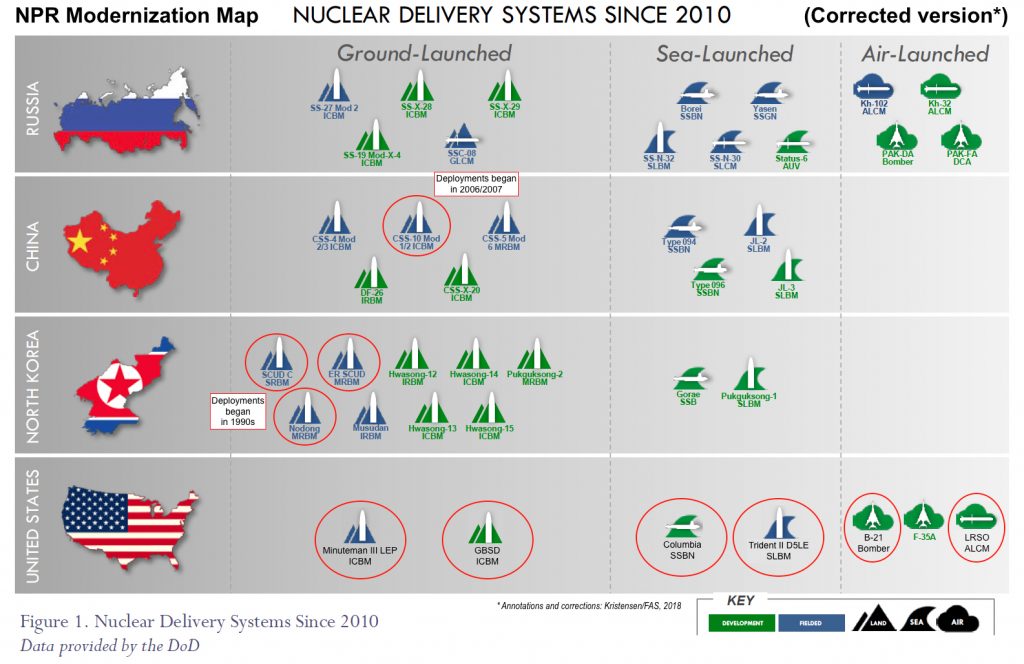
NPR chart earns three Pinocchios for misleading public: “A Pentagon chart misleadingly suggests the U.S. is falling behind in a nuclear arms race,” Washington Post, 2/12/2018
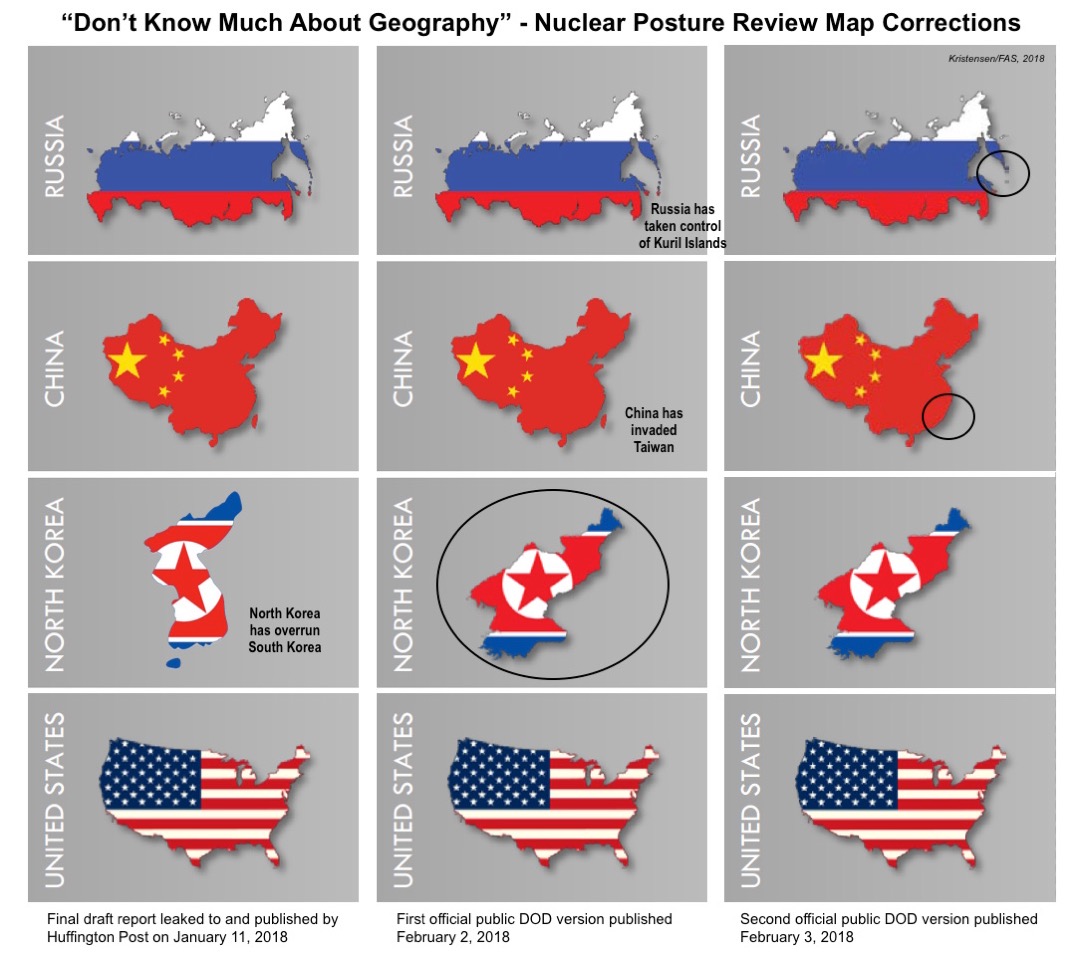
Geography graphics across the three versions of the Nuclear Posture Review (draft, official version, and updated version) with corrections and clarifications. (Hans Kristensen/FAS)
Anna Péczeli, “Continuity and change in the Trump administration’s Nuclear Posture Review,” Bulletin of the Atomic Scientists, 2/20/2018
John R. Harvey, et al., “Continuity and Change in U.S. Nuclear Policy,” Real Clear Defense, 2/7/2018
Steven Pifer, “Questions about the Nuclear Posture Review, Brookings, 2/5/2018
Matthew Harries, “A nervous Nuclear Posture Review,” IISS, 2/5/2018
Rebecca Hersman, “Nuclear Posture Review: The More Things Change, The More They Stay the Same,” Defense Outlook 2018 (CSIS), 2/2018
James Acton (CEIP), “Command and Control in the Nuclear Posture Review: Right Problem, Wrong Solution,” War on the Rocks, 2/5/2018
Andy Weber, “Trump Call for New Nukes Will Make America Less Safe,” The Cipher Brief, 2/4/2018
The Washington Post editorial, “Trump’s request for even more nuclear weapons is flawed overkill,” 2/3/2018
Alicia Sanders-Zakre (Arms Control Association), “Why we should reject Trump’s dangerous nuclear plan,” Bulletin of the Atomic Scientists, 2/2/2018
Tom Z. Collina (Ploughshares), “Give Trump more nuclear weapons and more ways to use them? Not a good idea,” CNN, 2/2/2018
Rachel Bronson, Sharon Squassoni, Hans M. Kristensen, and Alicia Sanders-Zakre, “The experts on the Nuclear Posture Review,” Bulletin of the Atomic Scientists, 2/2/2018
Anne Armstrong and Cassandra Varanka, “Taking on Trump’s Dangerous Nuclear Posture Review,” Ms. Magazine blog, 2/2/2018
Jon Wolfsthal (Global Zero), “US Approach to Russia in New Nuclear Posture Review Risks Boosting Chances of Conflict,” Russia Matters, 2/2/2018
Joe Cirincione (Ploughshares), “Nuclear Nuts: Trump’s New Policy Hypes The Threat and Brings Us Closer to War,” Defense One, 2/2/2018
Michaela Dodge (Heritage), “5 Myths About the Nuclear Posture Review,” Daily Signal, 2/2/2018
Mark Perry, “Trump’s Nuke Plan Raising Alarm Among Military Brass,” The American Conservative, 2/2/2018
William J. Hennigan, “Donald Trump Is Playing a Dangerous Game of Nuclear Poker,” Time Magazine, 1/1/2018
Paul Bracken (Yale), “The 2018 Nuclear Posture Review: Signaling Restraint with Stipulations,” FPRI, 2/1/2018
16 US Senators, Letter to the President on the NPR, 1/29, 2018
Rep. Adam Smith, “Smith Statement on the Nuclear Posture Review,” House Armed Services Committee Democrats, 1/24/2018
Lisbeth Gronlund and Stephen Young, “The U.S.’s Dangerous New Nuclear Policy,” Aviation Week, 1/26/2018
Michaela Dodge (Heritage), “Trump’s Nuclear Posture Review Must Keep us Safe,” National Review, 1/22/2018
Andy C. Weber (Harvard), “Trump Wants New Nukes. We Can’t Let Him Have Them,” Huffington Post, 1/19/2018
Michèle Flournoy, Interview with WNYC, 1/18/2018
Michael Krepon (Stimson), “The Most Dangerous Word in the Draft Nuclear Posture Review,” Defense One, 1/23/2018
Fred Kaplan, “Nuclear Posturing: Trump’s official nuclear policy isn’t that different from his predecessors.‘ That’s what makes it so scary,” Slate, 1/22/2018
Vince Manzo (CNA), “Give the Low -Yield SLBM its Day in Court,” Defense One, 1/22/2018
Joan Rohlfing, Jon Wolfsthal, Thomas Countryman, Arms Control Association briefing, Press Briefing with Experts on the Trump Nuclear Posture Review, 1/23/2018
George Perkovich (CEIP), “Really? We’re Gonna Nuke Russia for a Cyberattack?,” Politico, 1/2018
Loren Thompson (Lexington), “Trump’s Nuclear Strategy Is Basically The Same As Obama’s,” Forbes, 1/2018
Jon Wolfsthal and Richard Burt (Global Zero), “America and Russia May Find Themselves in a Nuclear Arms Race Once Again,” The National Interest, 1/2018
Tom Z Collina (Ploughshares Fund), “Give Trump new nukes and we are that much closer to war,” The Hill, 1/2018
The New York Times Editorial Board, “False Alarm Adds to Real Alarm About Trump’s Nuclear Risk,” 1/13/2018
Daryl G. Kimball, (Arms Control Association), “Trump’s More Dangerous Nuclear Posture,” Arms Control Today, 1/2018
Jon Wolfsthal (Global Zero), “Say No To New, Smaller Nuclear Weapons,” War on the Rocks, 11/2017
Brad Roberts (LLNL), “Strategic Stability Under Obama and Trump,” Survival, 7/2017
Jon Wolfsthal (Global Zero), “How Will Trump Change Nuclear Weapons Policy?” Arms Control Today, 11/2017
Robert Einhorn and Steven Pifer (Brookings), “Meeting U.S. Deterrence Requirements,” Brookings, 9/2017
The third Nuclear Posture Review set out from the start to produce an comprehensive public document. In this way, the review served several purposes: it provided an opportunity to interpret President Obama’s Prague commitment to seek the peace and security of a world without nuclear weapons, to explain the strategic benefits of the New START treaty and to establish the force structure to comply with it, and served as a prominent and public way of communicating with allies and adversaries. The central compact was that as long as nuclear weapons exist, the United States will maintain a safe, secure, and effective deterrent. In this way, the NPR could endorse modernization and sustainment investments while reducing the role and number of nuclear weapons. Though relatively modest in terms of force structure changes, the document’s main innovation was to declare that the United States will not use or threaten to use nuclear weapons against nonnuclear weapons states that are party to and remain in compliance with their obligations under the Nonproliferation Treaty.
The second NPR was marked by inventive concepts and poor public relations. The intention was to produce a classified document that would be briefed publicly. In open testimony, Undersecretary of Defense for Policy Doug Feith described the NPR as an attempt rethink deterrence for a world where Russia was no longer an enemy. The nation’s strategic posture would no longer depend on Mutual Assured Destruction, but one Feith said would have “the flexibility to tailor military capabilities to a wide spectrum of contingencies.” Operational concepts would rely more on prompt conventional strike and defensive capabilities. To enhance flexibility, the NPR seemed to endorse development of new earth-penetrating warheads and also required a responsive infrastructure that could quickly produce and test new capabilities if a threat arose. Moving away from MAD allowed for a reduction of deployed warheads below 2,200, but the NPR mandated no further modifications to force structure. Three months after the initial briefing, selections of the classified report leaked to the media and were widely criticized by arms control groups and foreign officials. Fairly or unfairly, many read the leaked sections as blurring the line between nuclear and conventional weapons and refusing to accept mutual vulnerability. Administration officials scrambled to clarify but never fully dispelled concerns, leaving more questions than answers.
President Clinton ordered the first NPR to examine the role of nuclear weapons after the end of the Cold War. A five-person steering group led six working groups. The established process broke down in the summer of 1994 over tensions the steering group and the military stakeholders. In the end, the review failed to generate a unitary document; its results were briefed to the press and to Congress. The 1994 NPR established a force structure to comply with the START II Treaty and ordered cuts to each leg of the triad: conversion of four Ohio-class submarines and all B-1 bombers to conventional missions, reduction in B-52 and Minuteman III inventories, and elimination of Minuteman II and Peacekeeper ICBMs. Secretary of Defense Bill Perry summarized the NPR as an attempt to provide leadership for further reductions while hedging against the emergence of threats.
The National Nuclear Security Administration (NNSA) has published its long-awaited Stockpile Stewardship and Management Plan (SSMP) for Fiscal Year 2018. The SSMP is NNSA’s 25-year strategic program of record.
I’ll leave it to others to analyze the infrastructure and fissile material portions and focus on the nuclear weapons life-extension programs (LEPs) and cost estimates.
This year’s plan shows complex LEPs that are making progress but also getting more expensive (some even with funding gaps). There are some surprises (the retirement of the B61-10 tactical bomb), some sloppiness (the stockpile table has not been updated), and some questionable depictions (how to cut stockpile in half with no effect on average warhead age).
Nonetheless, the SSMP is a unique and important document and a service to the public discussion about the scope and management of the nuclear weapons arsenal and infrastructure. NNSA deserves credit for producing and publishing the SSMP. As such, it is a reminder that other nuclear-armed states should also publish factual overviews of their nuclear weapons programs to enable fact-based discussions and counter unsubstantiated rumors and worst-case suspicion.
Nuclear Nuts and Bolts
The 2017 SSMP does not update the nuclear stockpile number but continues to use the 4,018-warhead number (as of September 2016) declassified by the Obama administration in January 2017. The Trump administration has yet to declassify any nuclear stockpile numbers. The number now is estimated at around 4,000.
The report includes a graph that shows the average warhead age in the stockpile over the years. The graph shows the age continued to increase until about 2009, at which point it slowed until leveling out in 2014, presumably because of the significant production of W76-1 warheads (an LEP resets the warhead age to zero). In 2016, the average age began to drop, presumably because of the Obama administration’s 500-warhead cut in 2016 and continued production of the W76-1.
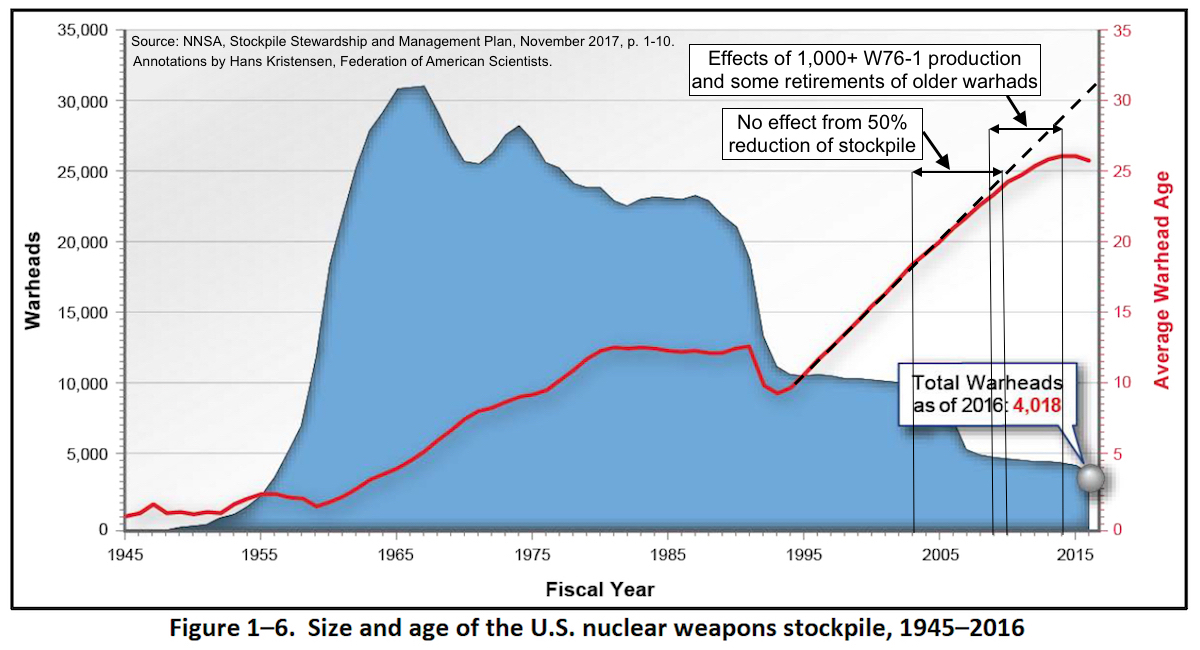
NNSA’s average warhead graph shows no effect from W Bush administration’s massive nuclear stockpile reduction. Click to view full size.
The near-continuous age increase through 2003-2007 is curious, however, because it shows hardly any visible effect from the massive stockpile reduction that occurred in those years. Why did a 50-percent reduction of the stockpile in 2003-2007 not have any effect on the average age of the remaining stockpiled warheads, when a 12-percent reduction in 2016 did? (The reductions in 1992-1994 also had a clear effect on the average warhead age.)
For that to be true, NNSA would have had to retire precisely the same portion of newer and older warheads of each warhead type, which seems odd.
The report reveals that the B61-10 tactical bomb was quietly retired in September 2016. The B61-10 has been in the inactive stockpile since 2006. The retirement is a surprise because the B61-10 is one of four B61 versions NNSA has listed to be consolidated into the B61-12. Once the B61-12 was produced and certified, so the argument was, the older versions would be retired.
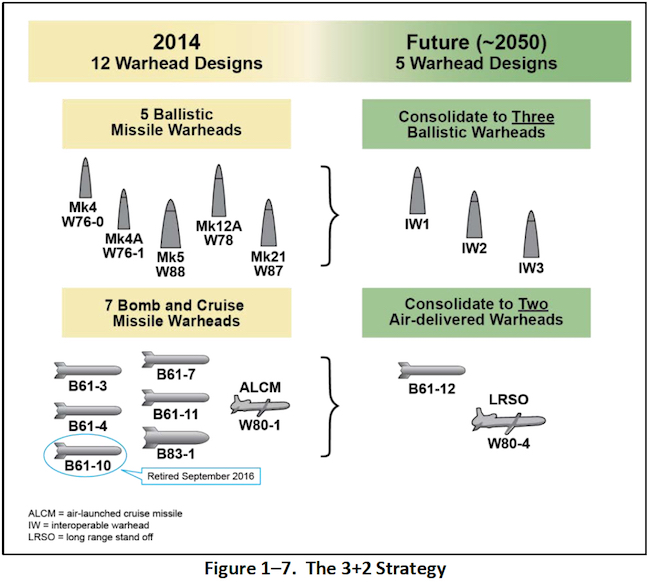
The 2017 SSMP reveals that the B61-10 tactical bombs has been retired but continues to list the weapon as part of the B61-12 “consolidation” plan.
Despite the B61-10 retirement, officials have continued to include the weapon in the “consolidation” justification for the B61-12 during congressional hearings in 2017. In fact, the 2017 SSMP itself continues to include the B61-10 in its description of the B61-12 programs: “will consolidate four versions of the B61 into a single variant.”
Despite the B61-10 retirement, the SSMP’s main table of the current nuclear weapons and associated delivery vehicles still lists the bomb (another table in the report does not list the B61-10).
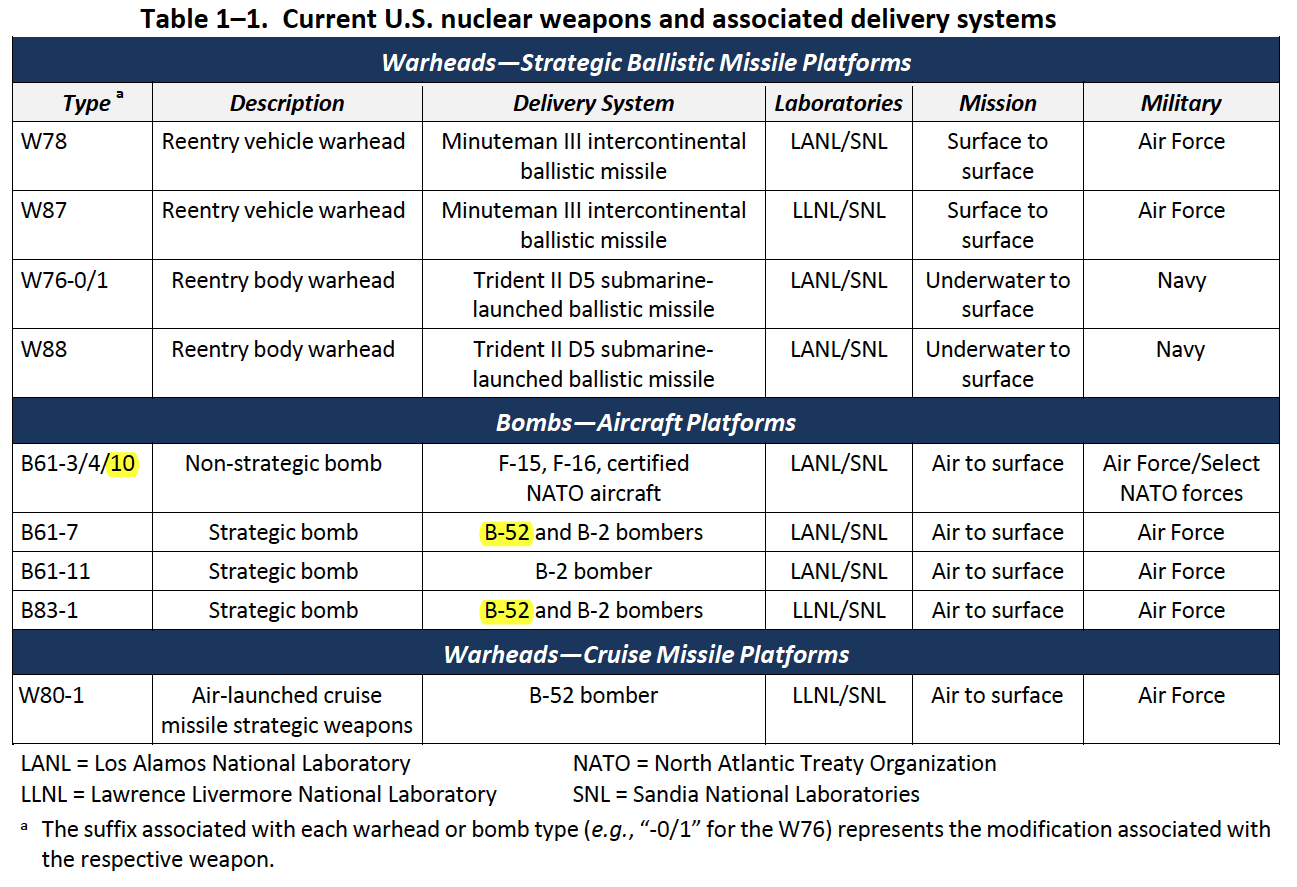
The SSMP report’s main table for the arsenal lists the B61-10 even though it has been retired, and gravity bombs for the B-52H even though it no longer caries them.
That table also lists the B-52H as carrying gravity bombs, even though other government documents no longer list gravity bombs assigned to the bomber. The authors appear to have done a sloppy job and simply copied the table from the 2016 SSMP without updating it.
The 2017 SSMP breaks down the extensive nuclear weapons modernization plan:
The 2017 SSMP also reaffirms the commitment to the “3+2” warhead strategy (which actually is a 6+2 strategy) even though the program is too expensive and potentially threatens the US nuclear testing moratorium. The “3” are so-called “interoperable warheads” intended for deployment on the ICBMs and SLBMs. The SSMP describes the Nuclear Weapons Council’s definition of an IW as “an interoperable NEP [Nuclear Explosive Package], with adaptable non-nuclear components on SLBMs and ICBMs.”
But even though “[f]inal designs of NEPs for the IW1, IW2, and IW3 warheads are yet to be determined,” the SSMP nonetheless confidently declares that the “3+2 Strategy preserves confidence in the stockpile’s operational reliability and effectiveness, while mitigating risk and uncertainty.” IW1 production is not expected until 2031, and I bet there are a couple of more design evaluations and decisions before NNSA can make any realistic assessment about reliability and effectiveness.
Moreover, I hear a lot of grumbling in the Navy and Air Force with concerns about introducing significantly modified warhead designs when the existing versions work just fine. Indeed, because the IW designs have not been tested in the assembled configuration envisioned, the 3+2 plan could introduce new uncertainties into the stockpile about warhead reliability and performance.
The Nuclear Posture Review is considering modifying a SLBM warhead to primary-only configuration to enable rapid low-yield strikes with ballistic missiles.
And The Money?
NNSA’s nuclear weapons budget has increased by 60 percent since 2010, and the agency is hoping for another $1 billion increase in 2018. In anticipation of the new NPR, the 2017 SSMP does not include budget numbers for 2019-2022 (the 2016 SSMP included these out-year numbers). And the detailed cost graph cuts off after 2018, unlike the 2016 SSMP graph that continued through 2021. But NNSA provides a new graph that plots expected weapons activities costs through 2042; there are significant changes compared with the graph included in the 2016 SSMP.
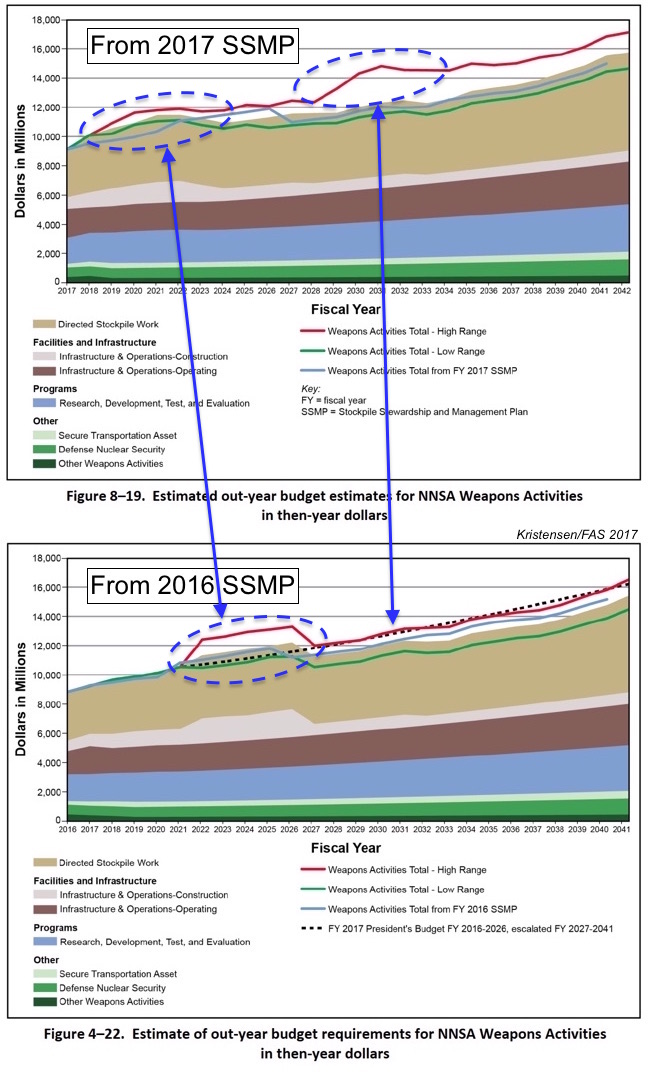
NNSA has restructure LEP spending plan so it moves “bow wave” up earlier, creates new bow wave later, and increases overall long-term costs.
It will take more time to analyze the data but a first impression is that NNSA has reorganized the projected costs so that the bow wave shown in the 2016 SSMP to appear in the 2020s now has been spread out and moved up so that it begins almost immediately and ends in the mid-2020s. Moreover, the graph shows a new high-range estimate cost emerging in the late-2020s and with significantly higher projections through 2042.
As part of that projection, all of NNSA’s LEPs high-end cost estimates appear to have increased, and there are still funding gaps toward the end of some of the programs, a budgeting problem that has previously been pointed out by GAO.
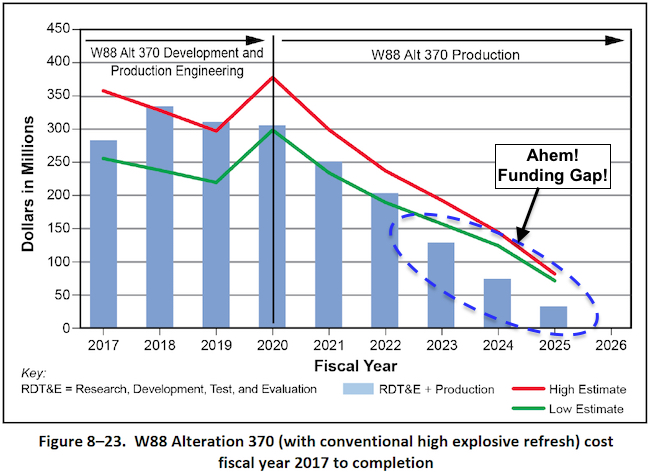
Some LEP programs appear to have insufficient funding.
And if you think the $10 billion B61-12 program is expensive, just check out the high-end cost estimate for the next B61 LEP (known as B61-13): a whopping $13.7 billion to $26.3 billion. Combined, in NNSA’s illustration, all the LEPs add up to $1.4 billion in 2017, increasing to nearly $2 billion per year in 2021-2037, and then ballooning to more than $2.8 billion per year by 2041.
Production Infrastructure
The 2017 SSMP also includes some interesting information about the production complex capacity, not least the planned production of plutonium pits at Los Alamos National Laboratory. Production is scheduled to increase from four pits in 2018 to 10 in 2024, 20 in 2025, 30 in 2026, and build capacity to produce 50-80 pits per year by 2030.
Later in the SSMP (p. A-10), it turns out the requirement for the 10, 20, and 30 pits in 2024, 2025, and 2026, respectively, actually is to produce “not less than” those numbers. And the requirement for 2030 is no less than 80 pits.
All of this of course hinges on if and how NNSA can complete the construction of the expensive production facilities needed.
Testing
The 2017 SSMP concludes that “there is no current requirement to conduct an underground nuclear test to maintain certification of any nuclear warhead.” That is good news. The 1993 Presidential Decision Directive (PDD-15, “Stockpile Stewardship”) directed NNSA to maintain the capability to conduct a nuclear test within 24 to 36 months, just in case a test was needed in the future.
But the 2017 SSMP states that NNSA has changed its assessment of what that guidance means and says “the fundamental approach taken to achieve test readiness has also changed.” Unlike the 2016 SSMP, the 2017 SSMP introduces a much shorter readiness timeline for a simple test:
This reassessment of the test readiness requirement appears to erode the US commitment to the testing moratorium. And it implies that NNSA is anticipating that future and more complex LEPs might potentially require “a simple test” with a nuclear yield. Such a test would be devastating to the international security environment and trigger a wave of nuclear tests in other nuclear-armed states.
For now, warhead development and surveillance rely on subcritical hydrodynamic tests, which are gradually becoming more complex and using more fissile material. The 2017 SSMP describes work is underway to develop an operational “enhanced capability” for subcritical experiments by the mid 2020s.
There were seven “integrated hydrodynamic experiments” conducted in 2016, including for what the SSMP describes as “stockpile options.” These options appear to be different from the known LEPs and stockpile maintenance efforts.
Conclusions and Recommendations
This is not even a Trump SSMP. The document describes the program of record: the maintenance and modernization plan initiated by the Obama administration. Yet in setting the policy framework for the 2017 SSMP, NNSA invokes president Trump’s January 2017 memorandum (NSPM-1) on rebuilding the armed forces to conduct a “new Nuclear Posture Review to ensure that the U.S. nuclear deterrent is modern, robust, flexible, resilient, ready, and appropriately tailored to deter 21st-century threats and reassure our allies.”
This formulation is different and much broader than the requirement listed in the 2016 SSMP, which required NNSA to “maintaining the safety, security, and effectiveness of the nuclear stockpile.”
From NSPM-1, the 2017 SSMP highlight an overall intension “to pursue peace through strength” and “give the President and the Secretary [of Defense] maximum strategic flexibility.”
“Maximum” is a dangerous requirement because it can be used to justify pursuit of all sorts of enhancements for the sake of improved capability. “Sufficient” is a much better word because it forces planners to think about how much is enough and balance this against other realities and requirements.
The Trump administration’s Nuclear Posture Review expected at the turn of the year will mainly be focused on implementing the main elements of the Obama administration’s nuclear modernization program, but it is also considering new weapons and modified warheads.
And the tone describing the international environment will certainly darken. In describing the strategic context, the 2017 SSMP unfortunately makes the usual mistake of lumping Russia in among the countries that are “expanding” their nuclear arsenals. In terms of the total number of launchers and warheads, that is not the case.
NNSA’s nuclear warhead modernization plan forms part of a boarder nuclear modernization plan that is unaffordable as currently designed. The Congressional Budget Office recently presented options for how to reduce the costs. Several of those options include scaling back or canceling warhead programs, options that NNSA should actively consider.
Modifying requirements and scaling back ambitions can have considerable effects on what the Nation gets in return for its investments. Consider for example that the complex $10 billion B61-12 LEP only adds 20 years of life for 480 warheads, while the simpler $4 billion W76-1 LEP adds 30 years of life for 1,600 warheads.
The early retirement of the B61-10, moreover, raises obvious questions about why some of the other “consolidation” versions (B61-3, -4, and -7) cannot also be retired early. Moreover, many B83s currently maintained in the stockpile could probably be retired early as well and dismantled.
On dismantlement, the 2017 SSMP is a clear step back. The requirement in the 2016 SSMP to accelerate dismantlement of warheads retired prior to 2009 has been deleted from the 2017 update. And while funding for dismantlement in the 2016 SSMP was increased to two percent of the directed stockpile budget, the 2017 report reduces the budget for warhead dismantlement and disposition to only one percent. Completion of dismantlement of warheads retired prior to 2009 is scheduled for September 2022 – one year later than the deadline listed in the 2016 SSMP. But the 2017 SSMP doesn’t even address what the plan is for dismantling the backlog of the roughly 1,000 warheads that have been retired after 2009.
While dismantlement is not a priority for NNSA or defense planners who are focused on modernization, it is an important and powerful message to the international community that the United States is not only modernizing but actually also scrapping nuclear weapons. After all, with no new arms control treaty to replace New START (not even negotiations), an INF treaty that is close to collapsing, rejection of the Ban Treaty, and rampant modernization programs underway to extend the nuclear era through the rest of this century, what else do we (and the other P5s) have to show at the nuclear Nonproliferation Treaty review conference in 2020?
This publication was made possible by a grant from the Carnegie Corporation of New York, the New Land Foundation, and the Ploughshares Fund. The statements made and views expressed are solely the responsibility of the author.